1lumen selects and reviews products personally. We may earn affiliate commissions through our links, which help support our testing.
RovyVon H3 Pro Hybrid Series Review
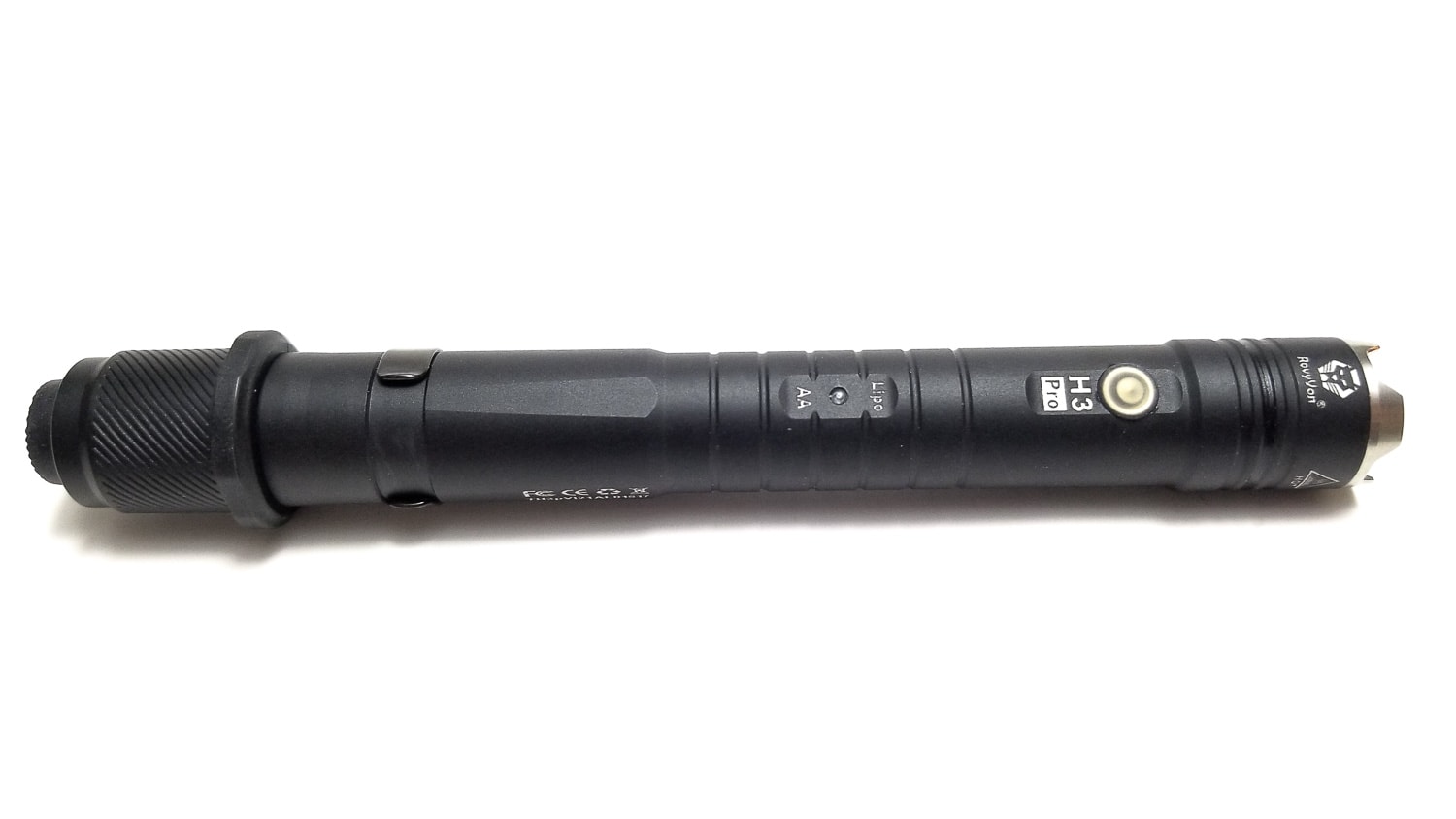
RovyVon H3 Pro specifications
| Brand/model | RovyVon H3 Pro |
|---|---|
| LED | CREE XP-L HI |
| Lumens | 600 Lumens Max |
| Beam intensity | 3,500 cd |
| Battery config. | 1*AA/14500 + built-in Li-po cell |
| Rechargeable | USB-C for built-in battery |
| Modes | 5 |
| Blinkies | Strobe |
| Reflector | Smooth |
| Waterproof | IPX7 |
| Review date | January 2022 |
Introduction:
Today I’ll be taking a look at a light from a manufacturer that definitely marches to the beat of a different drummer. This company’s products walk what I consider the fine line between niche and mainstream, and sort of reminds me of the Windows PC vs Apple conundrum, with faithful followers in both camps preaching and puffing the benefits and features of the respective brands.
I am of course referring to RovyVon, and you may or may not know this, but they are the portable lighting division of Shenzhen Runfree Equipment Technology Co. Ltd., who makes all kinds of gear and gadgets for outdoor activities. RovyVon has been around for about 10 years under the guidance of a chap named Chen, and has brought the industry some pretty innovative and amazingly engineered flashlights over the years: The Aurora EDC’s? Yep, RovyVon. The S series multi-emitter lights? Yah, RovyVon makes those too, and lots of other lights from the S2/Elite searchlight, to the expansive (and very expensive gorgeous Limited series in timascus) A-series lights.
Fun fact: RovyVon is the only flashlight brand to name a flashlight after a character from my favorite Clint Eastwood movie (guess who it is…answer in the conclusion). When I got the chance to review a new light from RovyVon you better believe I jumped on it. Today I’ll be taking a look at a very unique multipurpose EDC/utility light, the H3 Hybrid Pro. This is a unique dual-fuel pen light based on a built-in li-po battery with an optional removable AA or 14500 cell as the primary power source, all controlled by an innovative switching system. I even hear it has a simple UI as well. Hey, it’s a RovyVon, so I’m expecting good stuff (and yep, probably some quirks).
Package quality.
RovyVon’s packaging is in a word…nice. Not fancy or ostentatious, just nice. It would be good for retail sales duty as well with the hang tag and a picture of the light on front with features, specs, and blurbs galore on back. Inside, everything is nicely packed and riding in a thin molded carrier, and you get a nice assortment of accessories:
- RovyVon H3 Pro
- Lanyard
- 2 Spare o-rings
- Spare charge port cover
- Manual (if you can call it that)
- Warranty info card
- Short USB A to type C charging cable
No surprises here, and I like how they included a charge port cover (it will eventually break) and a really nice lanyard here as well. The USB cable is a bit short, but that’s okay. There’s no battery included because, well, it doesn’t really need one (more on that later). The manual? Well, it’s a manual only in the sense of the word since it’s basically a folded up piece of printer paper with some specs and basic operating instructions on one side and a runtime graph for the High setting with assembly diagram on the other. Keepin it simple, eh RovyVon?
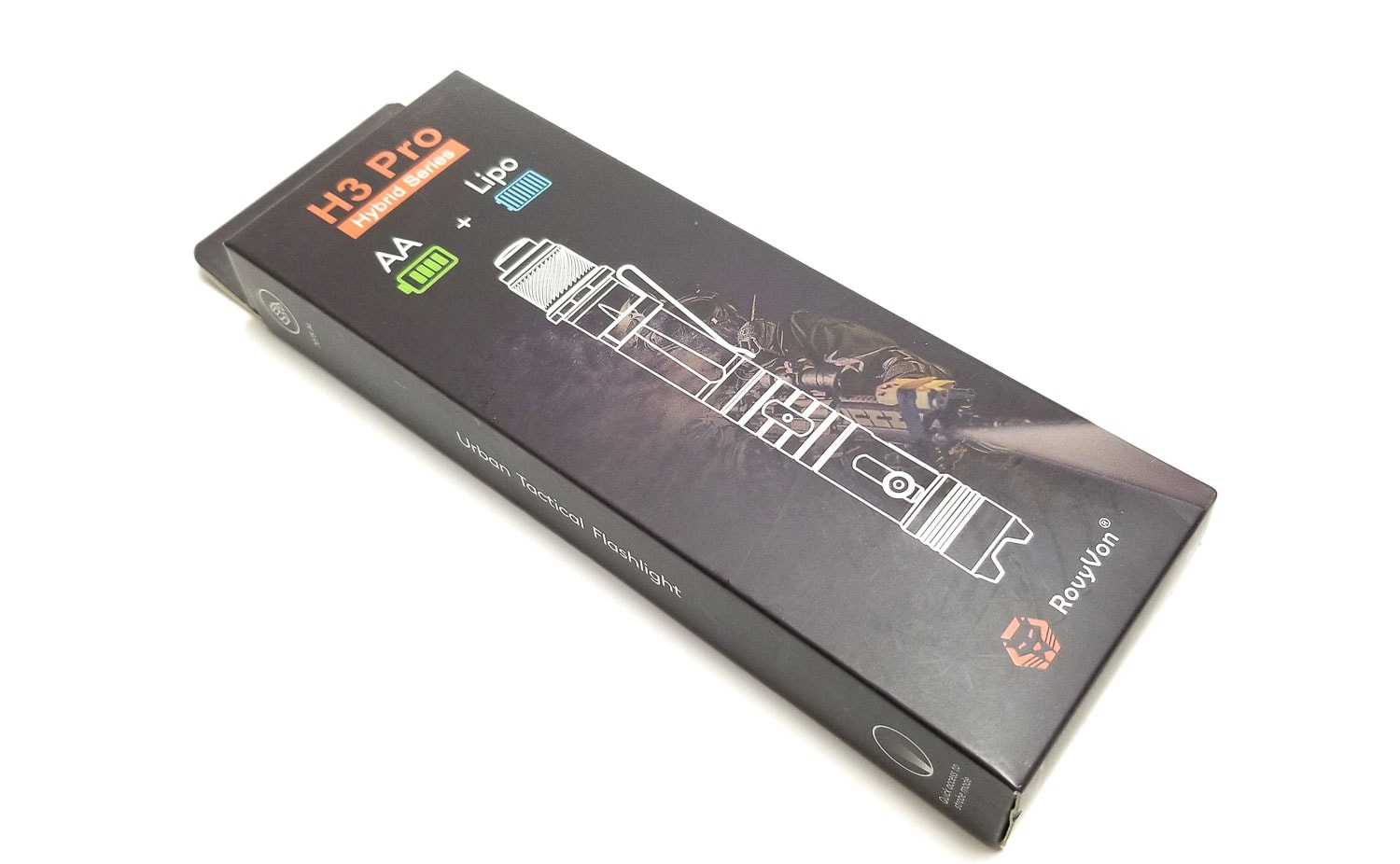
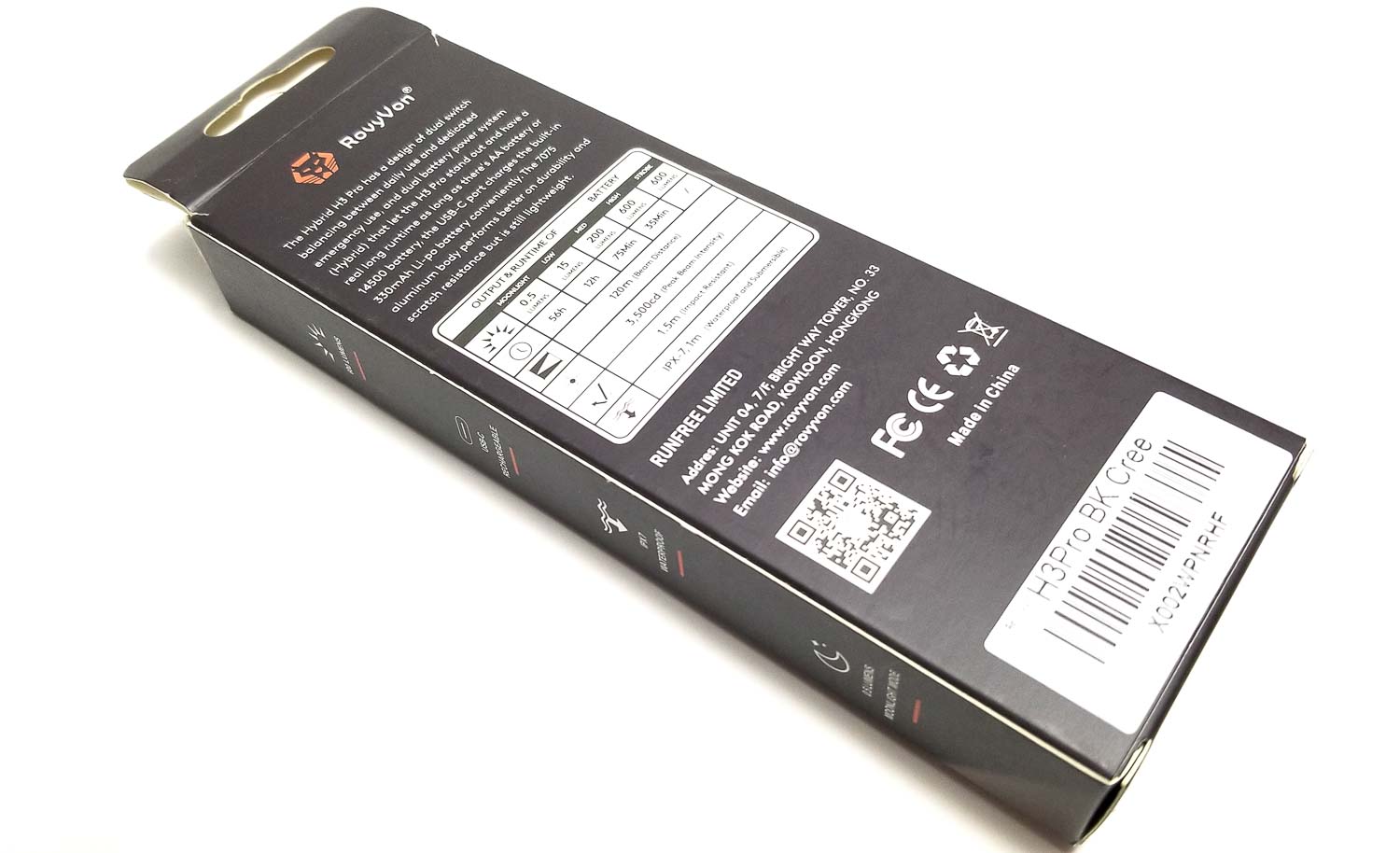


Flashlight in use
The H3 is profiled like a penlight more than tube light. It’s even slimmer than the 2xAA Thrunite Archer 2A V3, and that’s not a bad thing. I like how the H3 sits in my large hands without feeling awkward. The center of gravity is pretty neutral even without an AA battery onboard and that helps it point very naturally.
RovyVon omitted traditional knurling for circumferential grooves, and that’s just fine since the finish contributes to grippiness. The tailcap is removable, and has a unique spiral patterning engraved in for traction. There’s a couple of switches at work here. Like most all tactical style lights with an electronic side switch up front and a rear mechanical forward clicky switch out back. The e-switch needs some work. It has a small opaque rubber button that’s sized more for Frodo Baggins or Tinkerbell-sized fingers. For sausage-fingered folks like me, it kind of gets a bit lost and I found myself using the tip of my finger or edge of my fingernail to press it. Although it does have a soft click, it feels muted and the action is very short. On the plus side, it’s grippy and sticks out a bit so it was easy to find by feel.
There’s an LED indicator behind the e-switch that shows which battery you’re using, and an LED under the switch as well that shows battery state on start up (for about 3 seconds) and charging status. The rear forward clicky switch sticks out quite a bit so tail stands are a no-go, but it has great feel and a nice click action. RovyVon outfitted the H3 with a tactical grip ring (I found out it’s removable in an odd way…it comes off in 2 pieces), and it’s a tiny, plastic thing. It did help with a syringe grip well, maybe a cigarillo grip?
There’s a removable blackened stainless pocket clip for pocket carry or retention, and although a bit small, it has good tension and held on firmly. I’m not sure where the lanyard goes? There’s not a lanyard hole anywhere on the light, but there is a cutout on the pocket clip where you could thread it through.
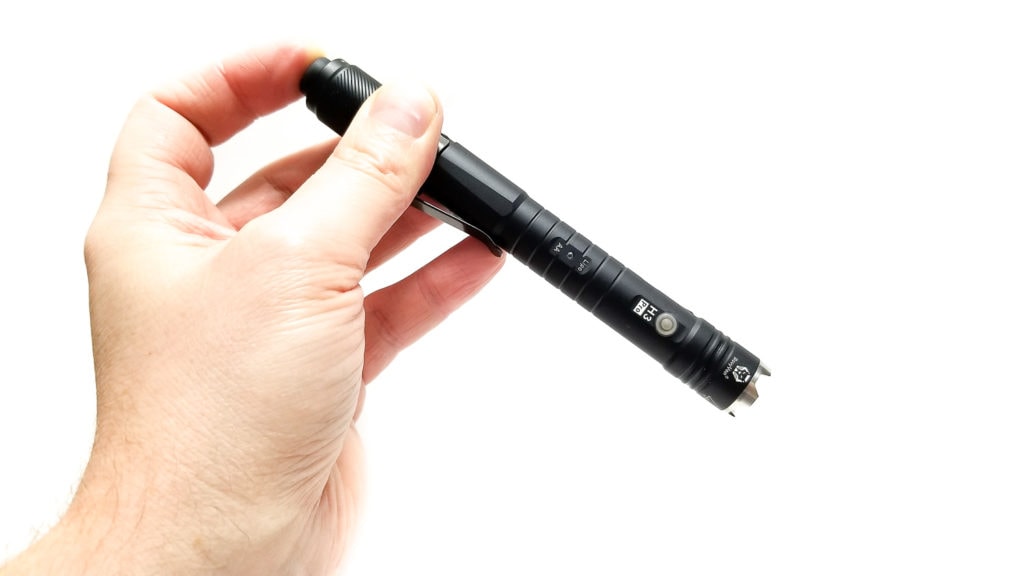
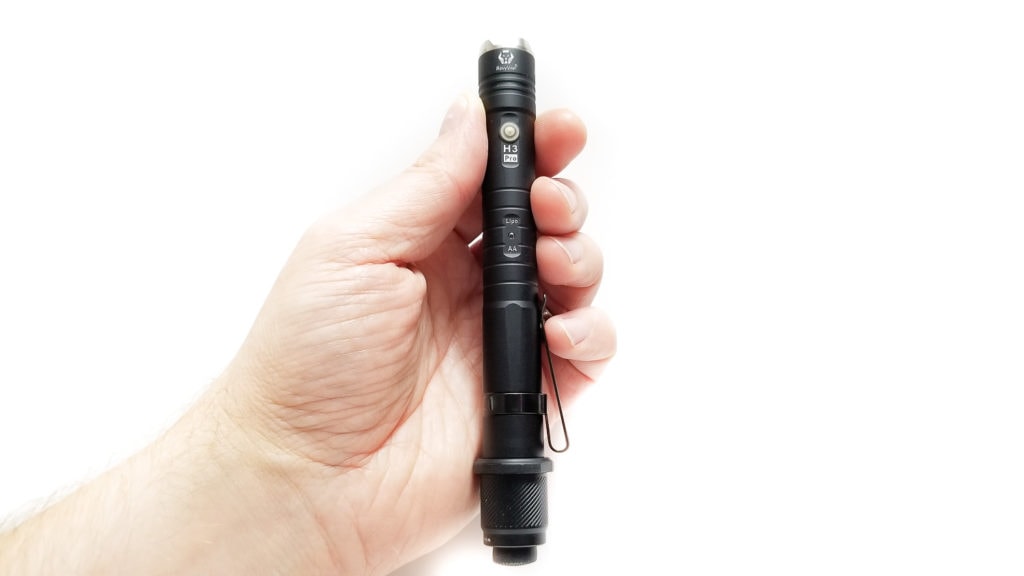
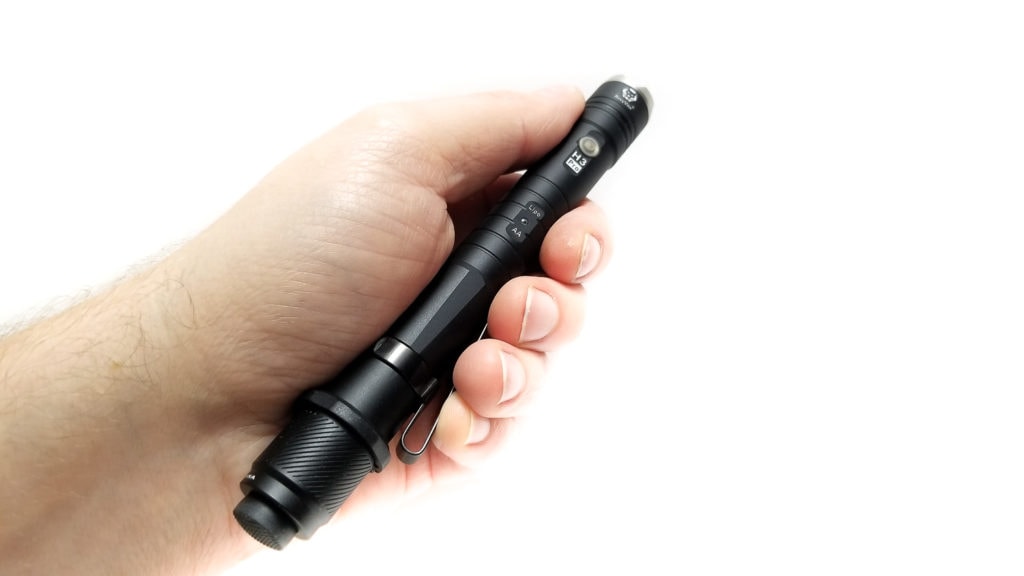
Build Quality, and Warranty
RovyVon is a well-known brand quality-wise amongst flashlight enthusiasts, but I don’t have much experience with them. I do know they make nice lights so it will be interesting to see if the H3 is worth the $50 US asking price since that’s kind of expensive for what amounts to a penlight.
Machined from 7075 aluminum alloy, the H3 Pro steps up the quality a bit from competitors in this segment. 7075 This is a superior alloy to the typical 6061. With the same T6 spec heat treatment, 7075 is tougher, more abrasion resistant, has much higher tensile and shear strength, which basically means it can take more abuse. The machining is perfectly fine with no defects or errant tool marks, and there aren’t any sharp edges anywhere, which is important on a pocket-carry light, and the stainless steel bezel is nicely-finished. The anodizing is an excellent, grippy, matte black type III HA. It’s really durable too and held up fine to my ham-fisted attempts at removing and replacing the pocket clip. All the parts, including the USB charge port, fit together fine with no gaps and I like the crisp graphics and text.
Except for the removable tailcap for accessing the removable battery, USB port, and accidentally discovering that the head wasn’t glued on (I don’t know if it’s supposed to be removed?), the light is sealed up good enough for an IPX7 rating (seems a bit low on a light in this price bracket). With the head off, you can see that the H3 Pro is a bit complex and the overall current path is…interesting. Under the head, there’s a pair of gold-plated pogo pins that interface with a PCB on the head.
The rear switch PCB looks to be held in with a retaining ring and instead of a spring, there’s 2 gold pogo pins that contact matching rings on the cell carrier rear PCB. The rear triangular cut threads are fully anodized, and the current path runs through the pogo pins. The threads are a bit fine but smooth and well-lubed. The head has pretty fine threads, and both ends are sealed with a single o-ring. The cell carrier seemed a bit flimsy, and was made from bendy plastic so I don’t know if it would hold up well, especially if it needs to be frequently removed to change out the battery. It was a bit tough to remove as well, and I thought my fingernail was going to break off, so I resorted to a flat blade screwdriver to pry it out. The carrier features a PCB on both ends that match up with pogo pins in the head and tailcap. The negative contact has a really small, gold-plated spring, and the PCBs are bridged with two 30 gauge (?) red/black wires. I know this doesn’t pull a ton of current, but still, 30 gauge seems a bit small. A solid metal strip would have been a better choice I think.
RovyVon is an established brand, and carries a decent warranty. There wasn’t much on the site to expound on that other than a 2-year warranty on all products except accessories.

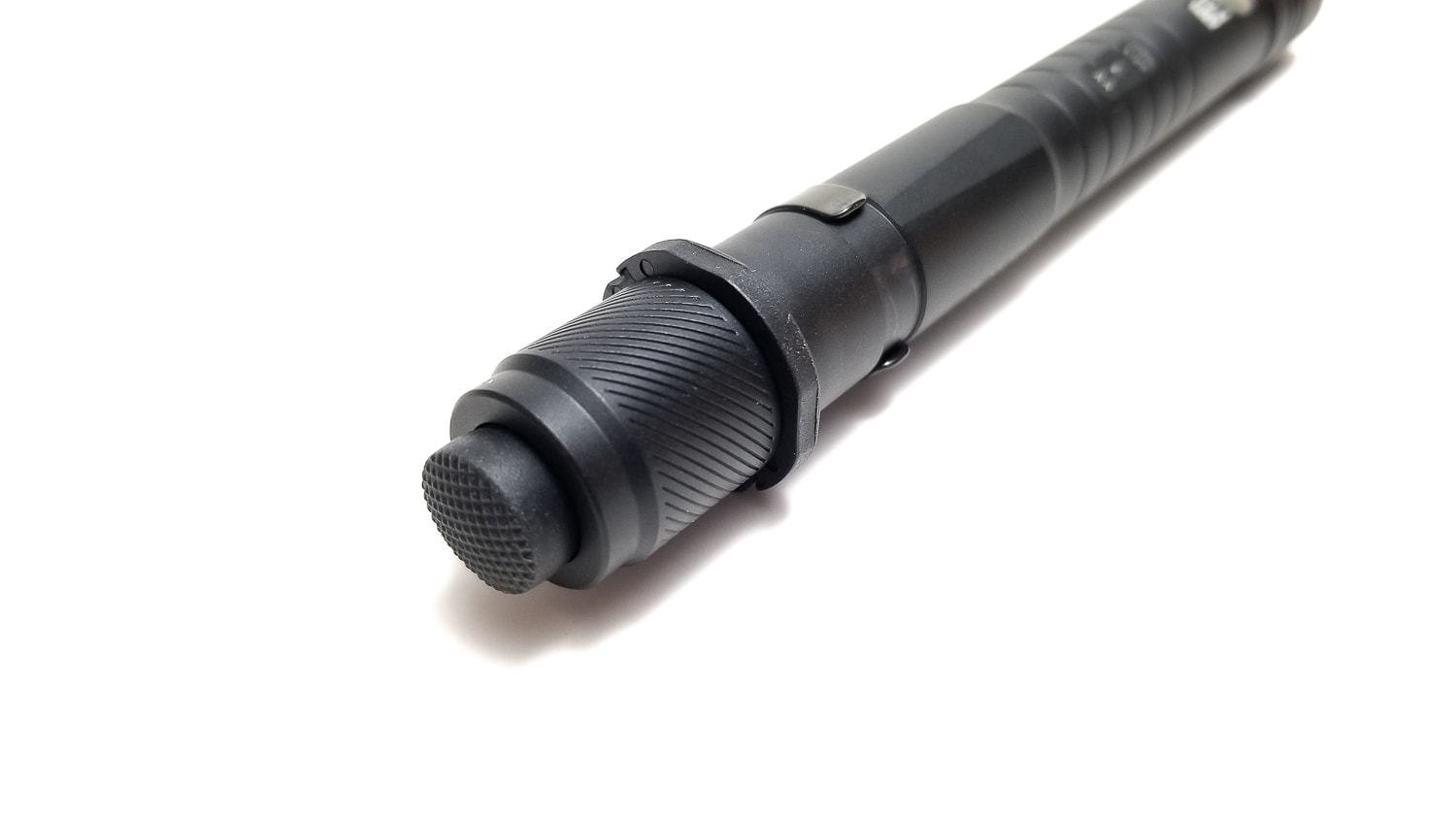
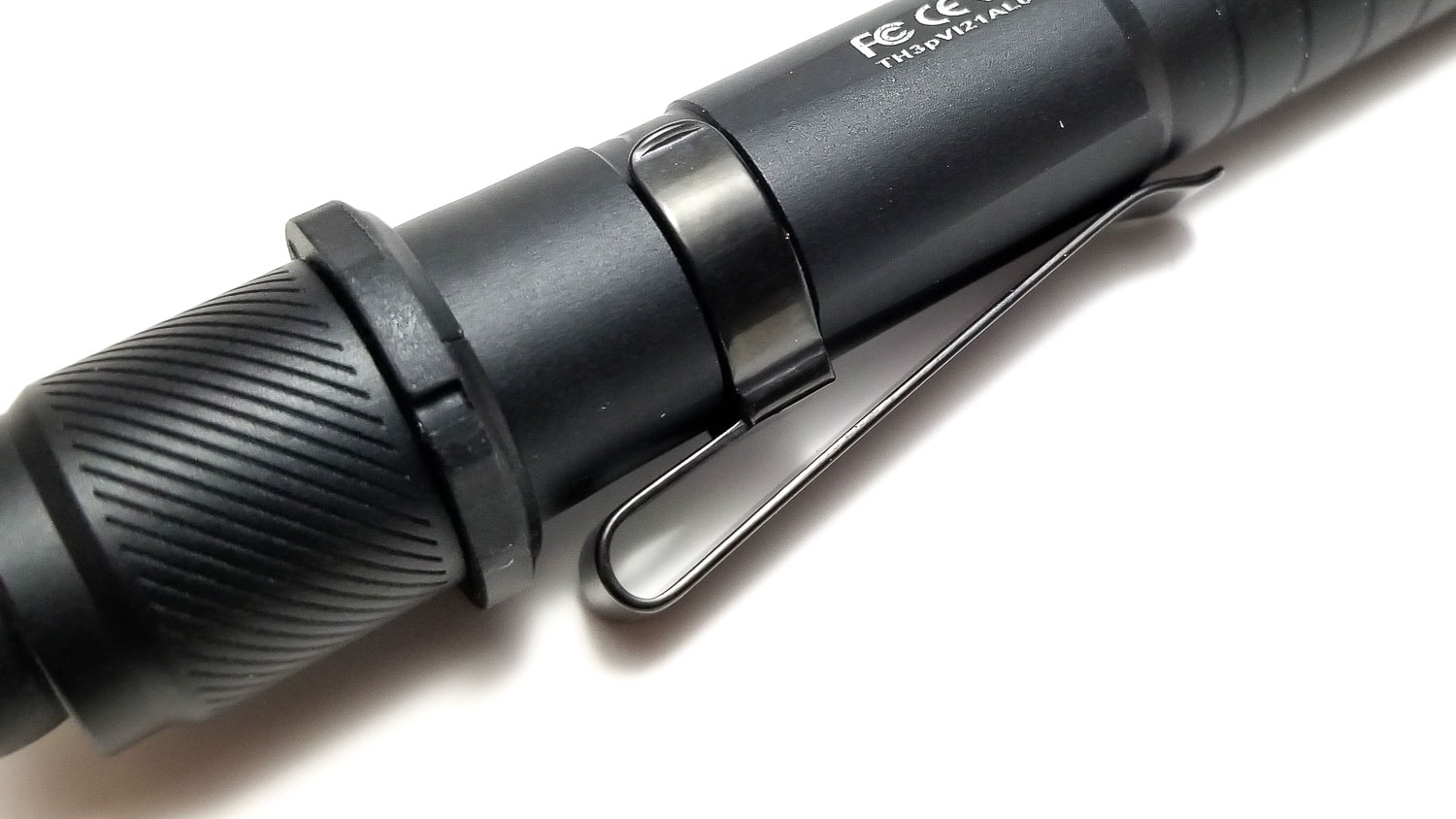



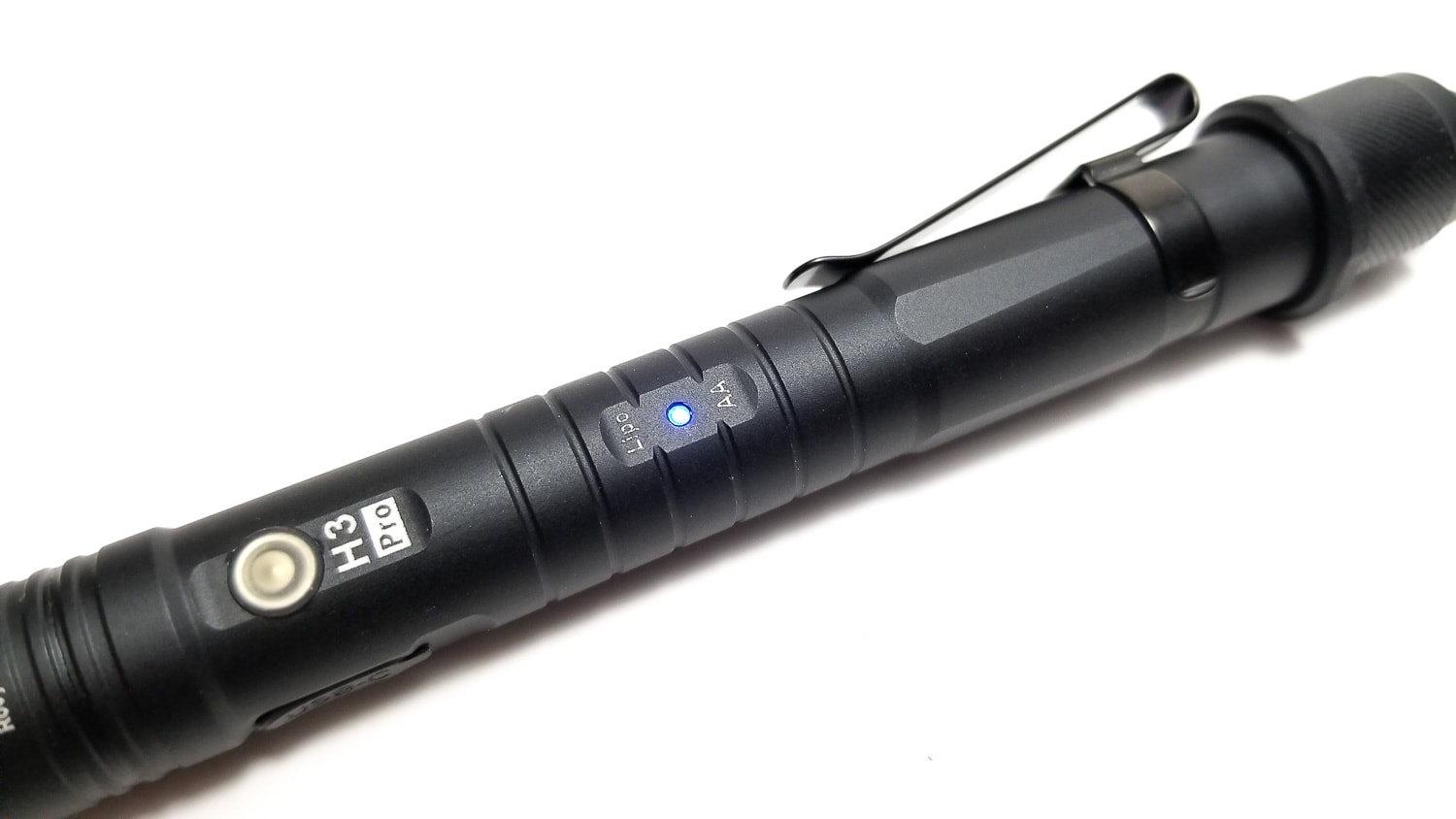
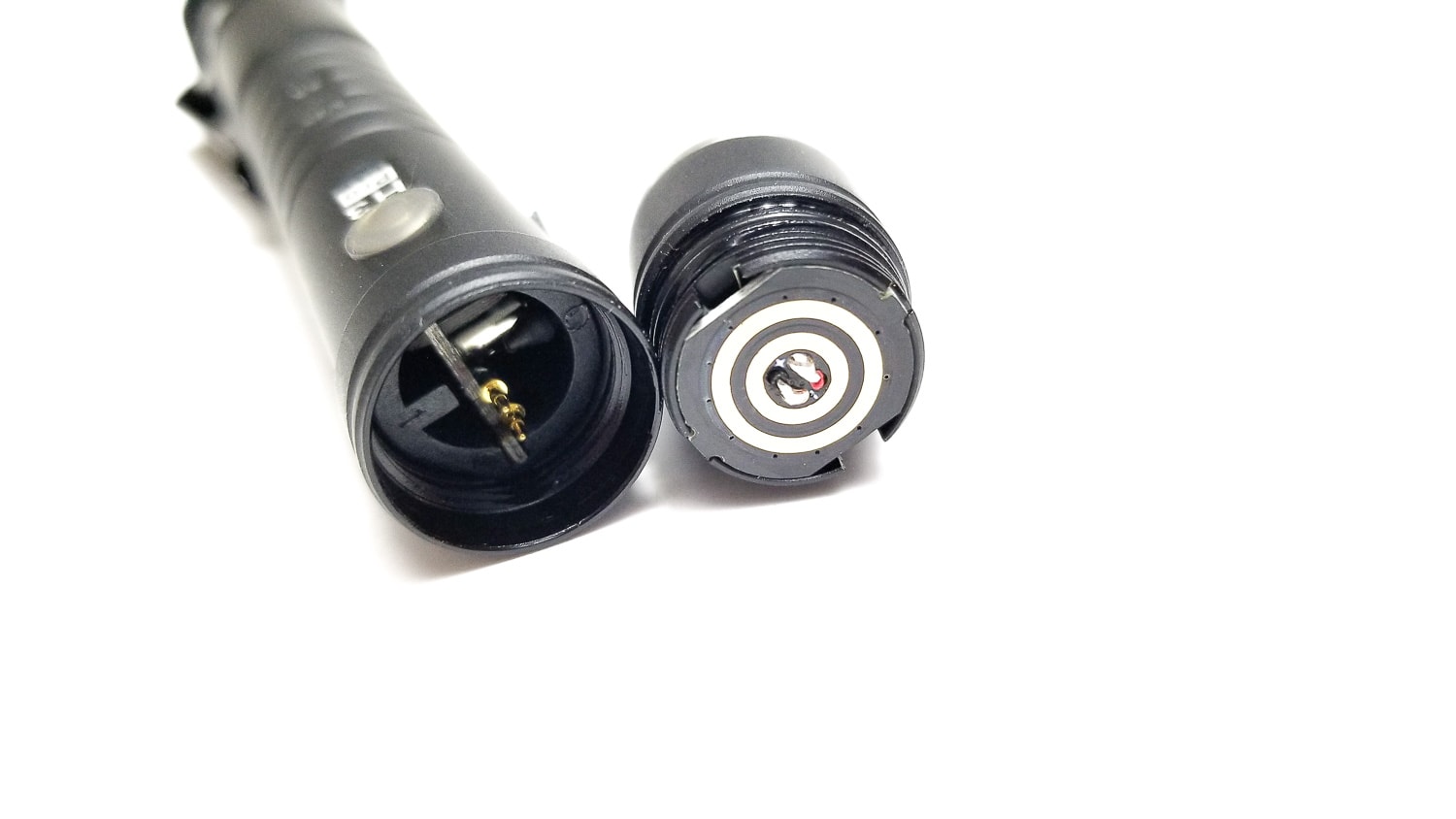
LED, Lens, Bezel, Beam, and Reflector
RovyVon could have stuck the latest-and-greatest Luminus SFT40, Boost HX, or LH351D, or even an SST20 in the H3 Pro, but instead chose the stalwart Cree XP-L HI. This emitter has been around the block a few times and proven itself to be a good performer. It’s not as bright as an SST40, but it’s still a good emitter. It sits on a 3535 size footprint, and comes from the factory without a dome so you get increased candela with a high cd/mm2, and it can be driven pretty hard with a lower Vf than the XM-L2 it replaces (and a bump in efficiency). For a small reflector light like the H3, it gives good output in a small package. Unlike the SST LEDs, you can get the XP-L HI in a ton of bins and tints, but alas, as is the way of the consumer-grade flashlight world, the H3 only comes in, you guessed it, cool white. Not a bad thing, and not the end of the world, but a warmer tint would have been nice, and I’m used to RovyVon outfitting their other lights with Nichia LEDs.
The H3 comes equipped with a small, nicely-finished SMO reflector topped with an aggressive strike bezel that looks a bit like it was lifted from Jaw’s grill (James Bond villain). It looks to be stainless steel or at least machined aluminum, and would do a good job protecting the lens (or you). The lens is a hardened mineral glass unit with AR coating that’s pretty unobtrusive.
The beam is very balanced with decent throw and a large focused (and artifact-free) hotspot. The outline of that aggressive bezel is visible on the fringes of the spill though. Overall, the beam is a nice fit for this type of light, with a great balance of spill and throw. The tint, while obviously cool white, was nice and didn’t detract from the beam quality or usefulness.
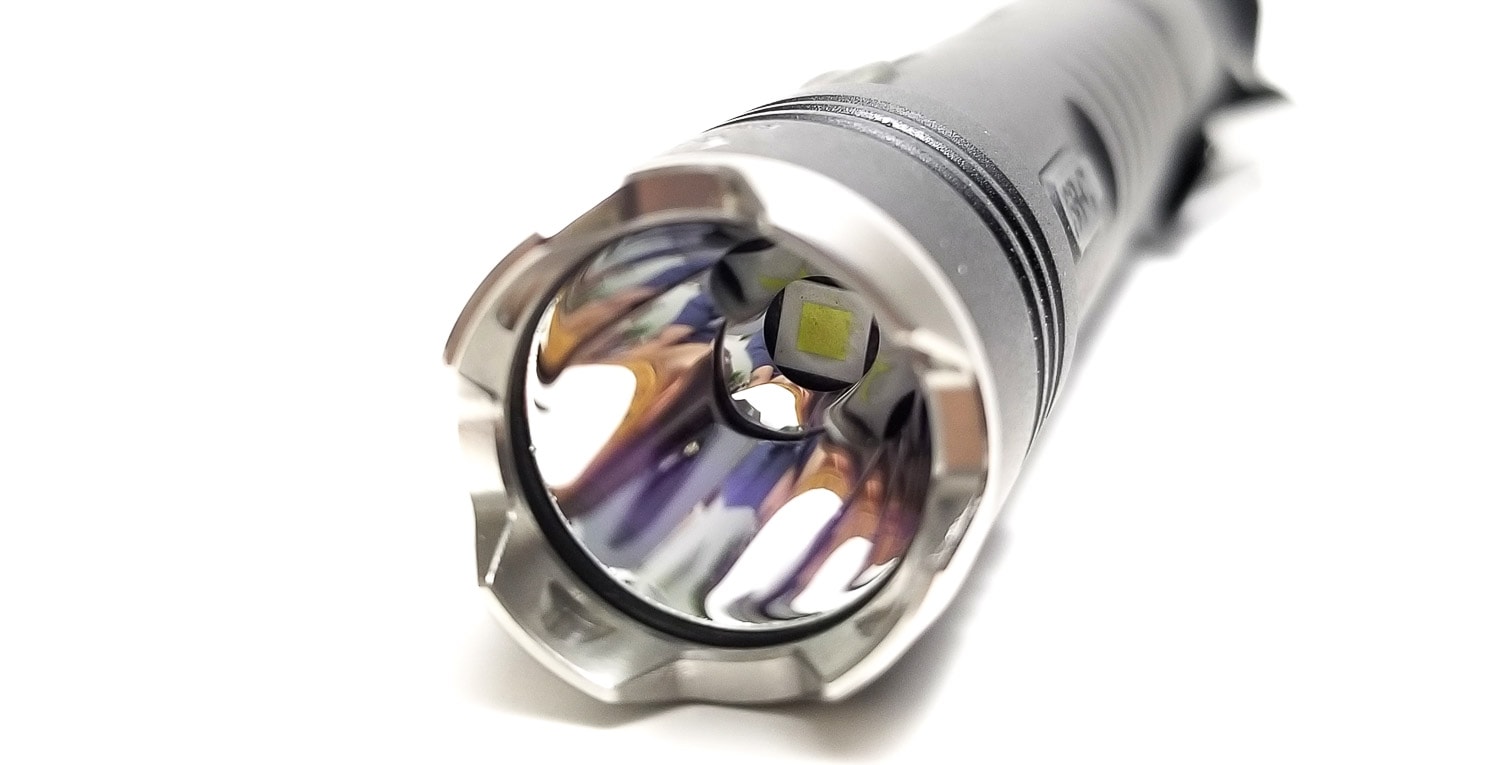
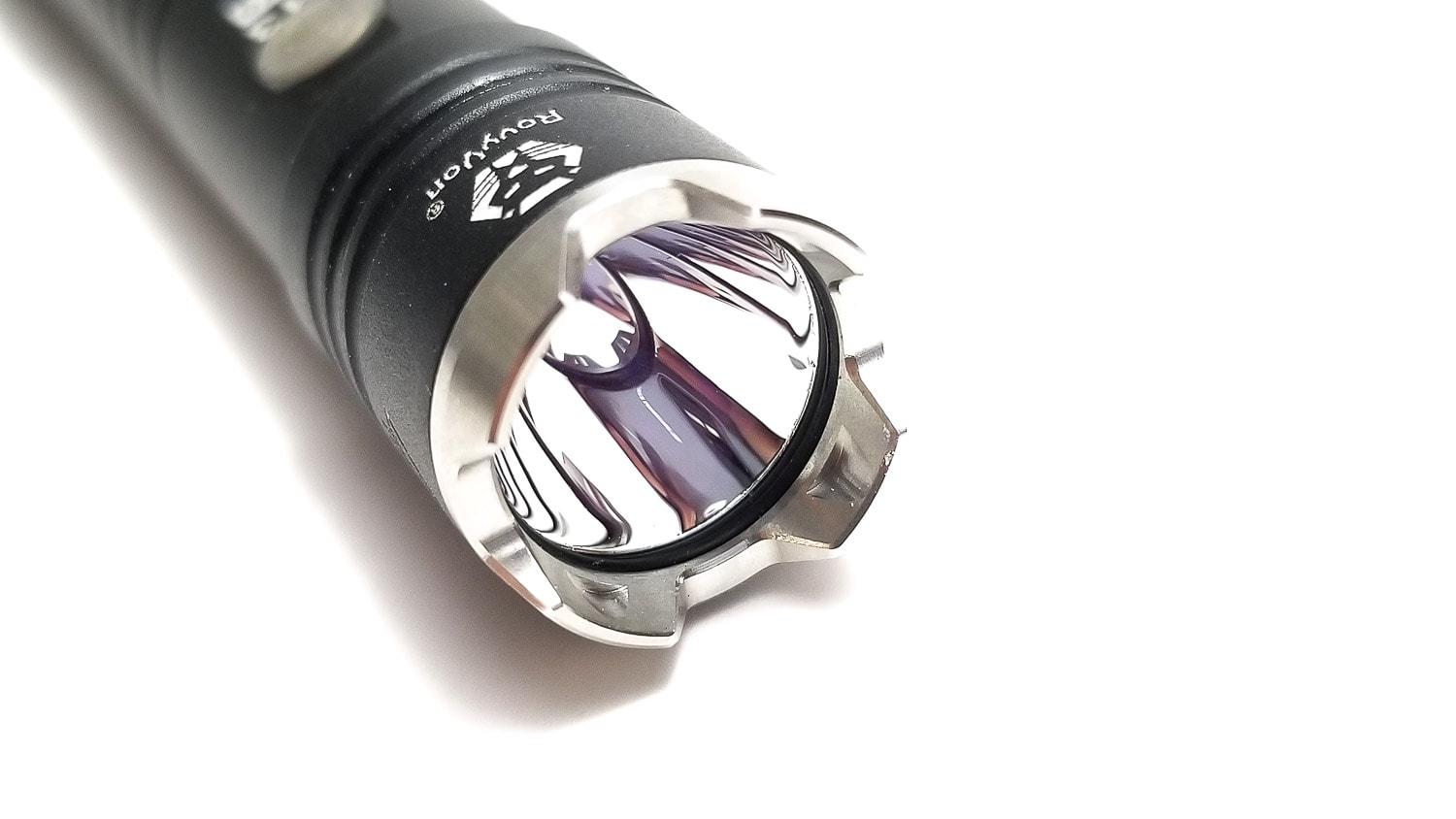
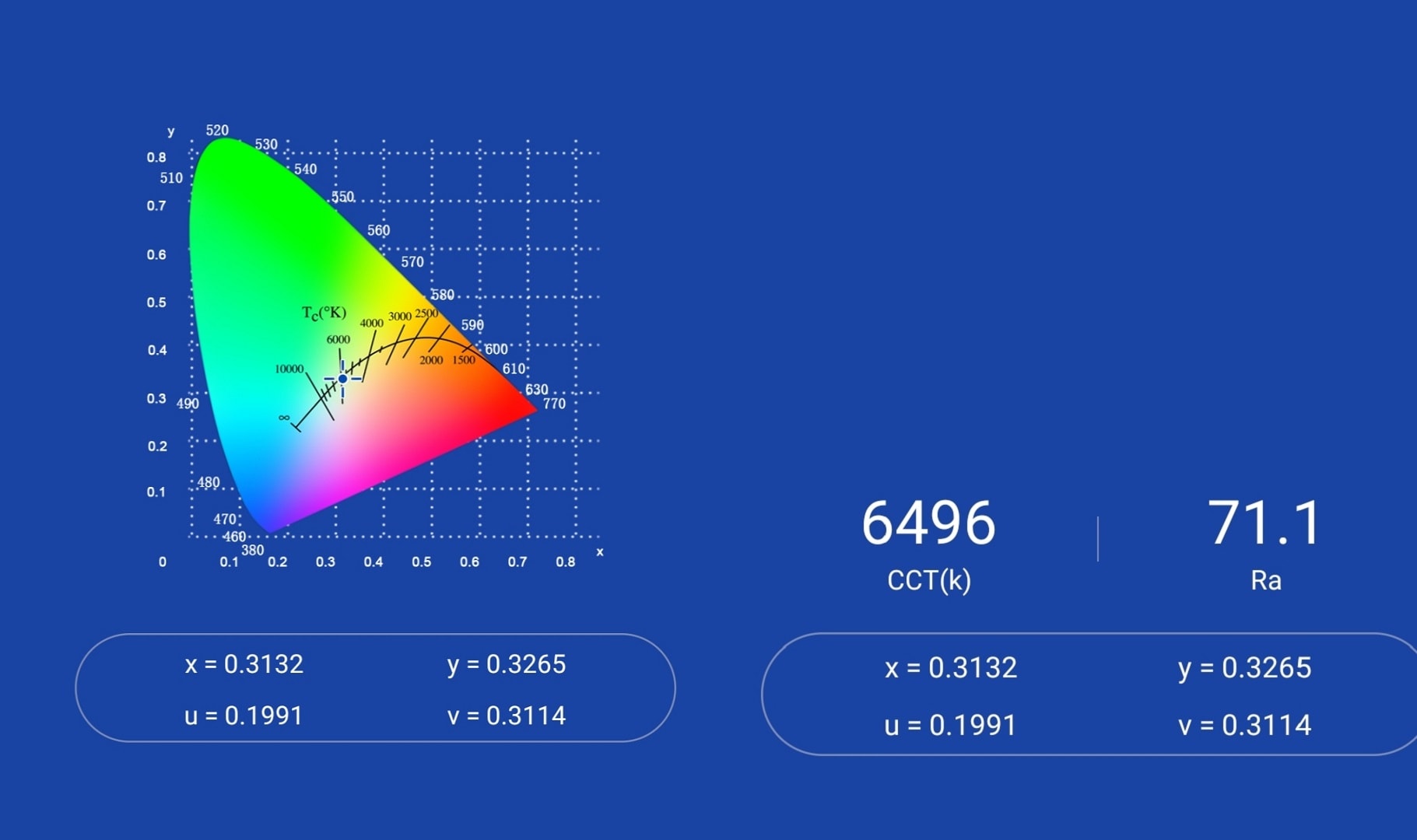
Dimensions and size comparison
- Length: 15.45 cm / 6.08 inches
- Diameter: 1.78 cm / 0.7 inches
Weight:
- With built-in battery: 48.1 grams / 2.93 oz.
- With built-in battery and Shockli 1000 mAh 14500: 68.1 grams / 4.65 oz.
Flashlight comparison
I compared the H3 Pro to some other 14500 / AA flashlights, slender lights I have. It’s comparable in size to the Thrunite Archer V2 3A in size, but a bit slimmer.
Group 1 left to right: Lumintop FWAA, Sofirn SC31T, RovyVon H3 Pro, Thrunite Archer V2 3A, Sofirn SP10v3
Group 2 top to bottom: Thrunite Archer V2 3A, RovyVon H3 Pro, Thorfire PF01
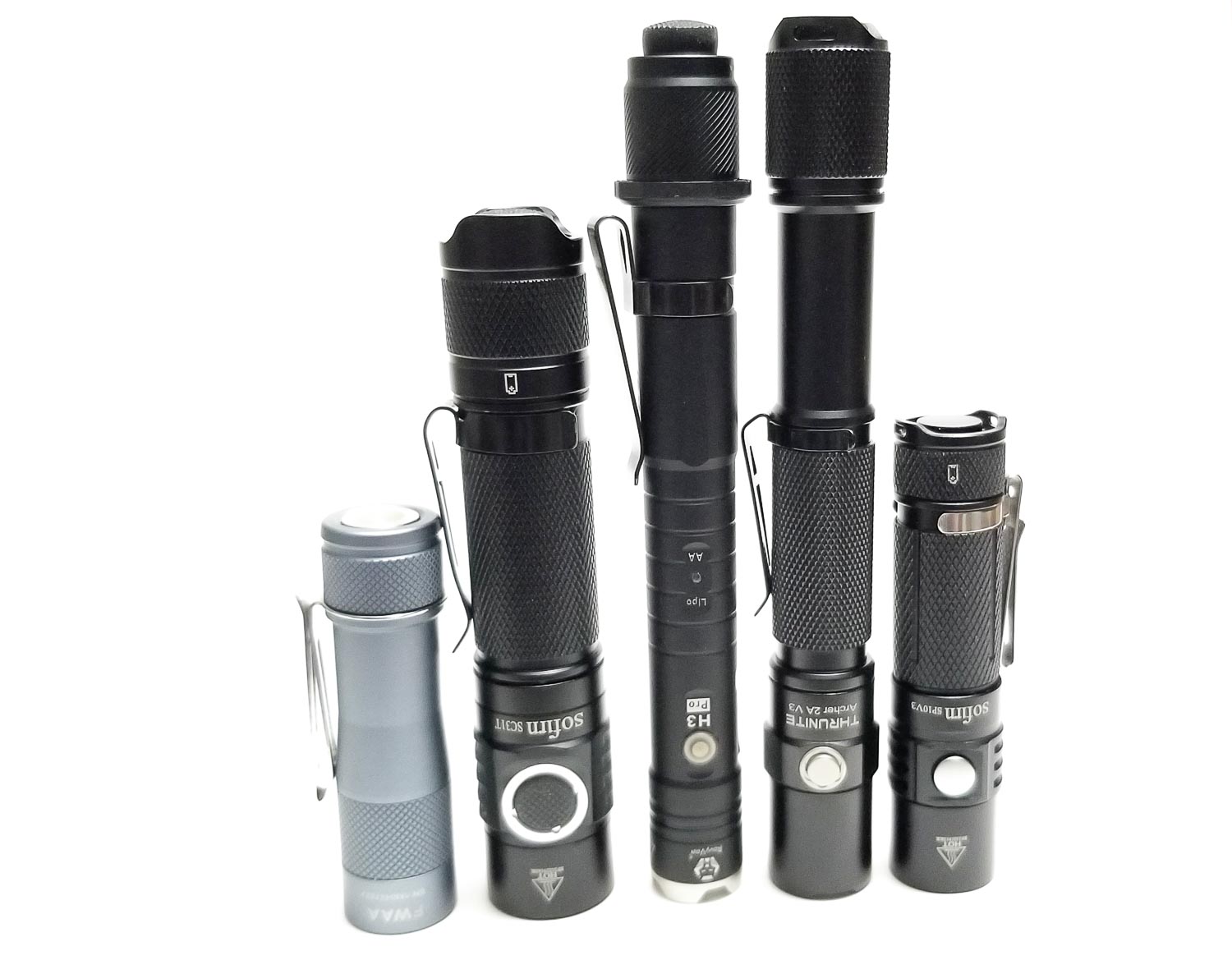
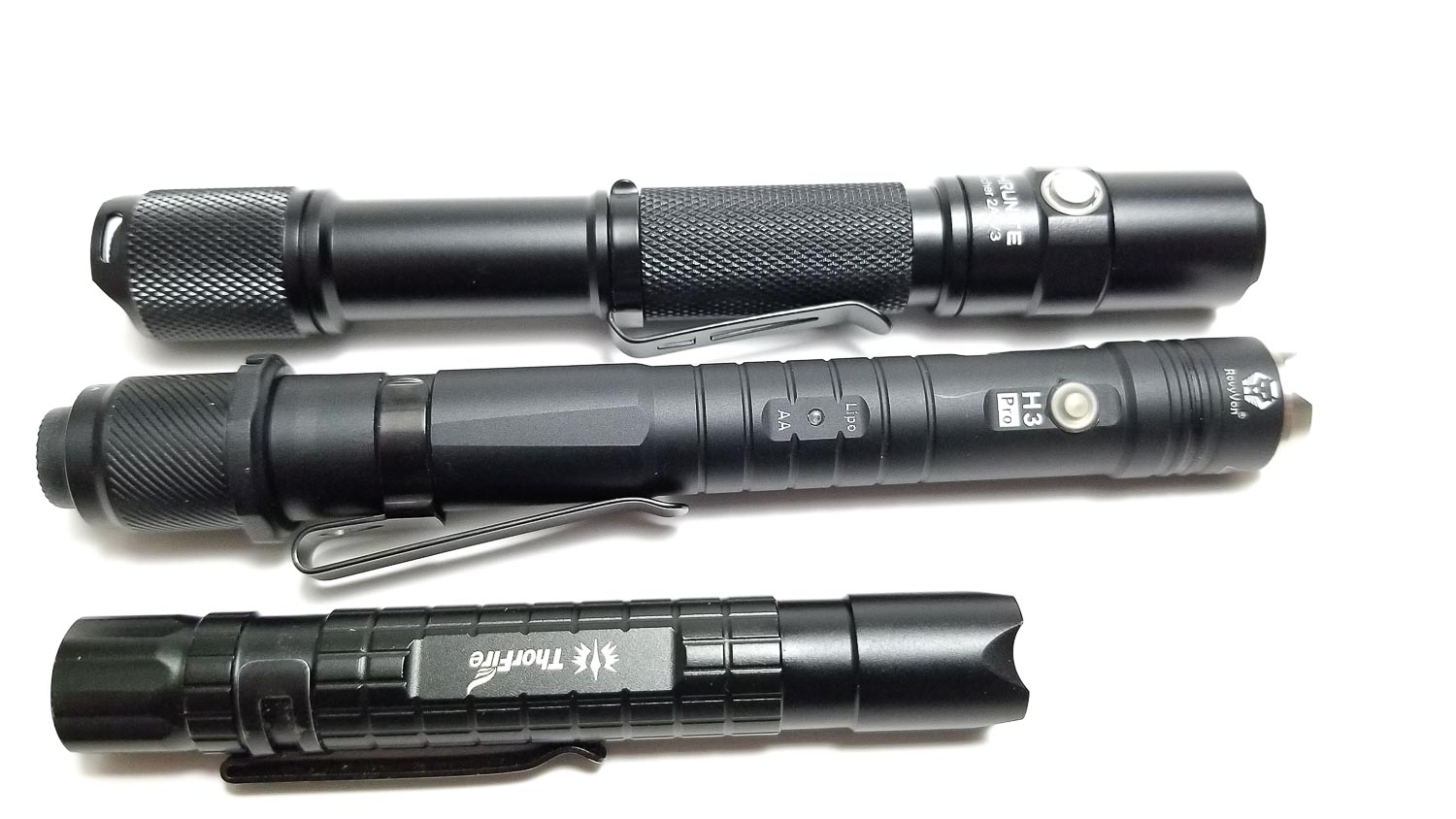
Driver & User Interface:
Since the H3 Pro can use an Alkaline or Nimh and a li-ion cell, there’s a boost driver hidden in there somewhere to step the 1.5 volts to the 3-something volts the LED needs. Combined with the multi-chemistry batteries, there’s some regulated wizardry in there because the higher voltage cells don’t run off a boost regulator, but are instead forced into a quasi-direct drive mode probably running off a resistor bank.
To be honest, I had a bit of angst since RovyVon UIs aren’t historically known for simplicity or intuitive operation. Hopefully, this one is an exception since they’re calling it ‘tactical.’ The H3 Pro has two switches with each having its own mode set. The side switch controls the ‘Daily’ modes and the rear forward clicky controls the “Tactical/Emergency’ modes. Overall it’s pretty simple with some quirks (what, it’s still a RovyVon).
Available modes: Moonlight, Low, Medium, High, Strobe
From OFF (Daily Mode):
- Double-click side switch: Turn on in last mode
- Single click side switch: N/A
- Press and hold side switch: Pressing and holding for more than 3 seconds switches between the batteries
From OFF (Tactical/Emergency Mode):
- Half-press rear switch: Momentary on. Switches between High-Strobe
- Full press rear switch: Continuous on in selected momentary mode
From ON (Daily Mode):
- Single click side switch: Cycles through modes M-L-M-H
- Press and hold (for 0.3 seconds): Turns off
- Double click: N/A
- Triple click:N/A
- Quad click: N/A
From ON (Tactical/Emergency Mode):
- Half-press OR full-press rear switch: Strobe
- Full press rear switch (when in Strobe): Turn off
Mode memory:
- Yes. The UI recalls last used mode when using the side switch, and if using the rear switch, you can enable a default mode memory for the first half or full press by leaving the light on for 3 seconds in that mode.
Shortcuts:
- To activate Strobe using the side switch in Daily Mode, half or full-press the rear switch. Release or fully click to go back to the previous mode.
Low voltage warning:
- RovyVon doesn’t make any succinct claims to LVP, but in my tests, the 14500 cells are discharged pretty deeply (one to 2.42 volts), and the Nimh was discharged to 1.1-1.13 volts, so I don’t know if I trust the LVP entirely. Per RovyVon, the light will not switch on if both batteries are too low (0.8 volts for the Alkaline/Nimh, 3.0 volts for the li-po/14500 cells). I can’t test the internal cell, but it probably follows the same algorithm as the removable li-ion. The switch LED will turn red and start blinking when the cell gets low and steps down the brightness very low before shutting down completely.
Strobe/blinkies
- Single strobe
Lock-out mode:
- N/A
PWM
- None!
Additional info on the UI:
- Okay, so the UI isn’t all that bad and more in line with regular lights I’m used to (that don’t have UIs starting with A and ending with nduril). The UI also incorporates the battery-swapping feature that allows switching between the built-in battery and the removable AA/14500 cell. From off, press and hold the side switch for about 3 seconds, and it will switch between the li-po and AA/14500. An LED indicator shows which cell is being used: Green for the removable cell, and blue for the built-in cell. It’s a neat system and I think it’s implemented well. The rear switch wears a couple hats, so to speak, and unlike some other tactical UIs, the rear switch will not cancel out the side switch function. If the light is turned on by the side switch and the rear switch is activated, the light will resume the last mode the side switch had selected. A bit unique. The UI itself is intuitive and easy to negotiate to the point I think a first-time user could master it relatively quickly. I’m not a huge fan of press and hold for off or the rapid double-click for on (a-la Acebeam E70) and it’s something I need to get used to. I like the rear switch as well. It’s really simple with just full and half presses in true ‘tactical’ (or tacti-cool at least) fashion.
Batteries & Charging
Okay, here’s where the “Hybrid” nature of the H3 Pro comes into play. Multi chemistry lights with the ability to use AA-size 14500 lithium-ion and Alkaline, Nicad, or Nimh 1.5 volt batteries are nothing new. However, the way RovyVon implements this is unique because they added a built-in cell to supplement the removable AA or 14500 battery. The tailcap unscrews to reveal a carrier for the AA battery, sort of like those cheap 3 AAA carriers that come with cheap zoomies. I am not a fan of these plastic carriers since they do break if you’re rough with them, and much prefer standard springs, so I’m not sure why RovyVon thought a carrier is a better option, but I digress. Per the manual, the removable battery is meant to be the primary power source by default, but you can switch between the two batteries at will with the e-switch. If there’s no battery in the carrier, the light defaults to the internal cell. This is neat because even if your removable battery goes flat, you can still use the light, so in theory, you’d never be without power (provided you keep the internal cell charged).
The built-in battery is a 330 mAh lithium polymer cell and that low capacity means truncated runtimes, but that’s okay because the internal cell is meant to be a backup. It’s recharged via a USB type C, which is a very welcome feature over the antiquated and rubbish micro USB connector. Of course, we all know the issue with built-in batteries is that once it goes flat, you toss the light (or send it back for replacement), but that’s less of an issue with the H3 Pro, so kudos to RovyVon on that since even if the internal cell goes flat it doesn’t become a paperweight. Unfortunately, only the internal battery can be recharged, and the charge current is spec’d at 500 mA. My USB tester showed about 470 mA on a 2.1 amp wall charger. On a type C to type C cable, the current was the same, and would charge the battery in under an hour (about 45 minutes until the charging indicator stayed steady). Nothing is mentioned in the manual, but the switch LED does turn blue and ‘breathes’ slowly when charging, turning solid to indicate a full charge. It also shows battery state during operation: Solid red for low battery, and blinking red for critically low battery.
My flat top Epoch 14500 fit fine, but my Ikea LADDA 2450 Nimh, Shockli black 14500, and Epoch 1000 mAh button tops were a bit too long and didn’t fit perfectly flush in the carrier, so the front of the battery would hang up on the inside of the tube and make it really difficult to insert and extract the carrier. Protected cells will definitely be too long, but RovyVon is aware of that and is working on a revised carrier.
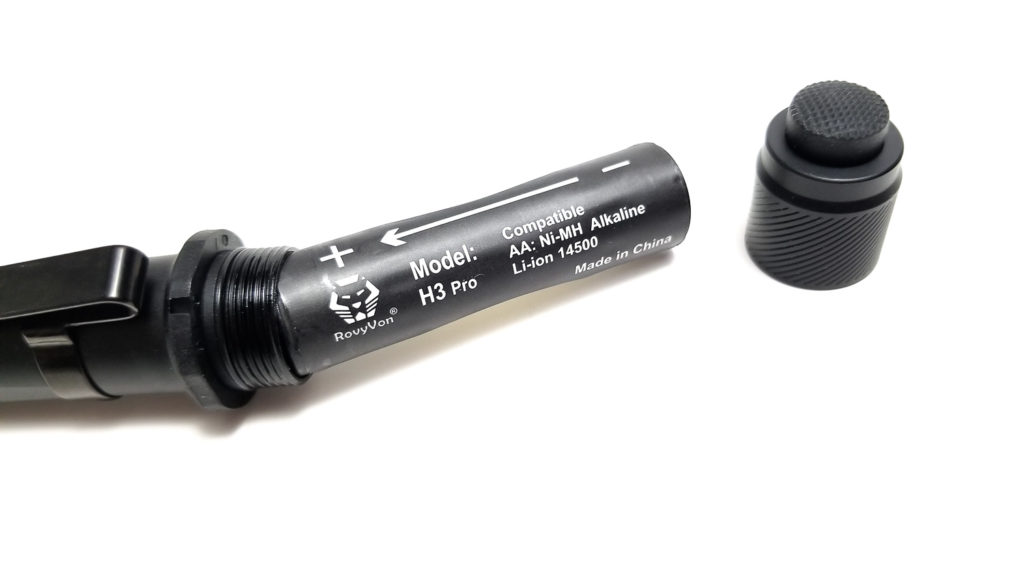
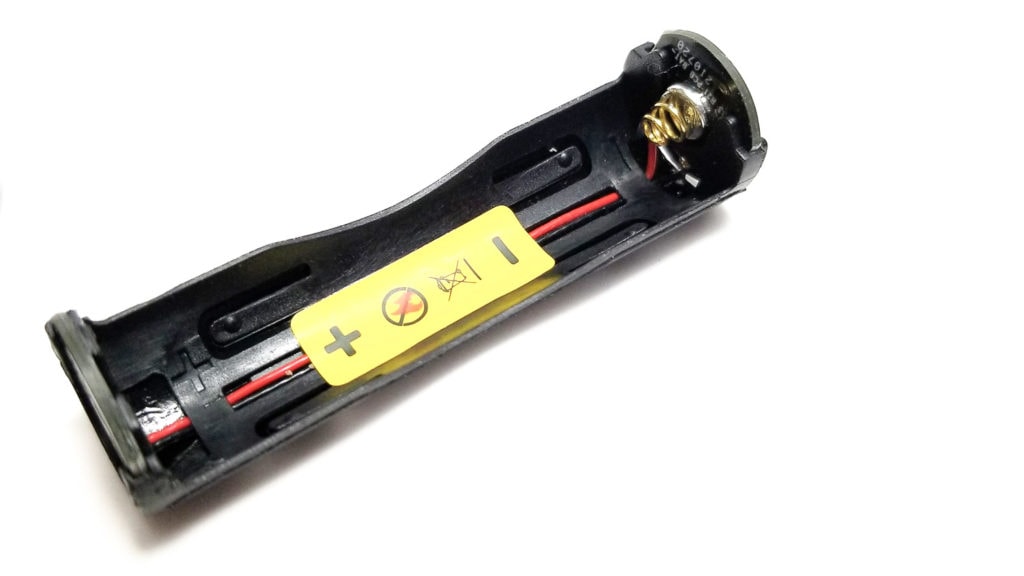
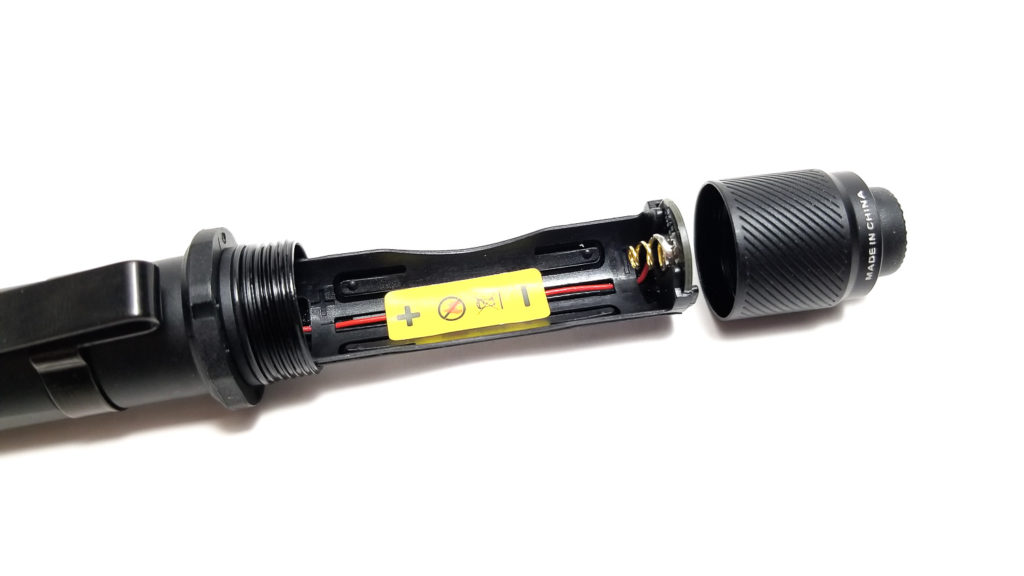
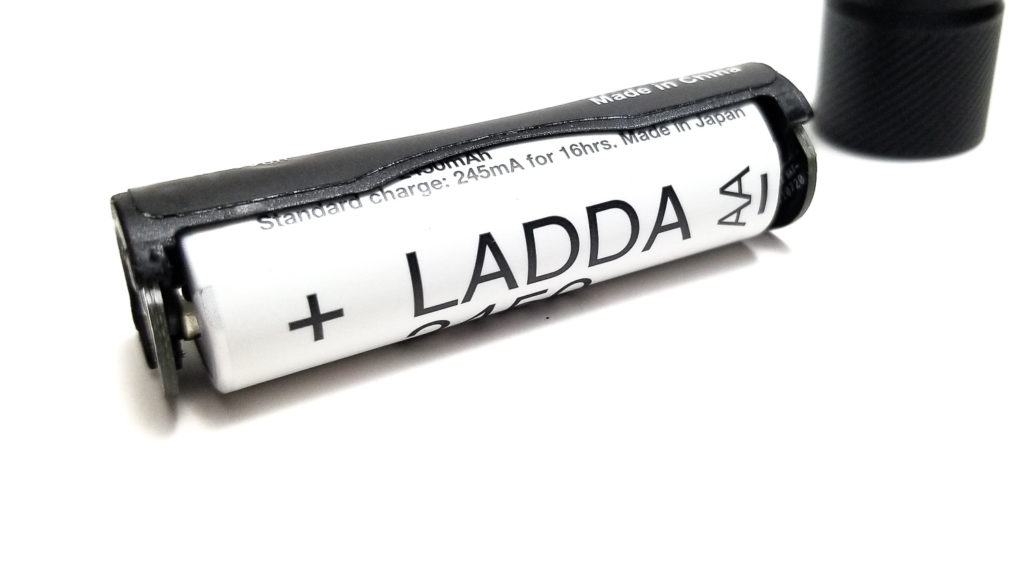
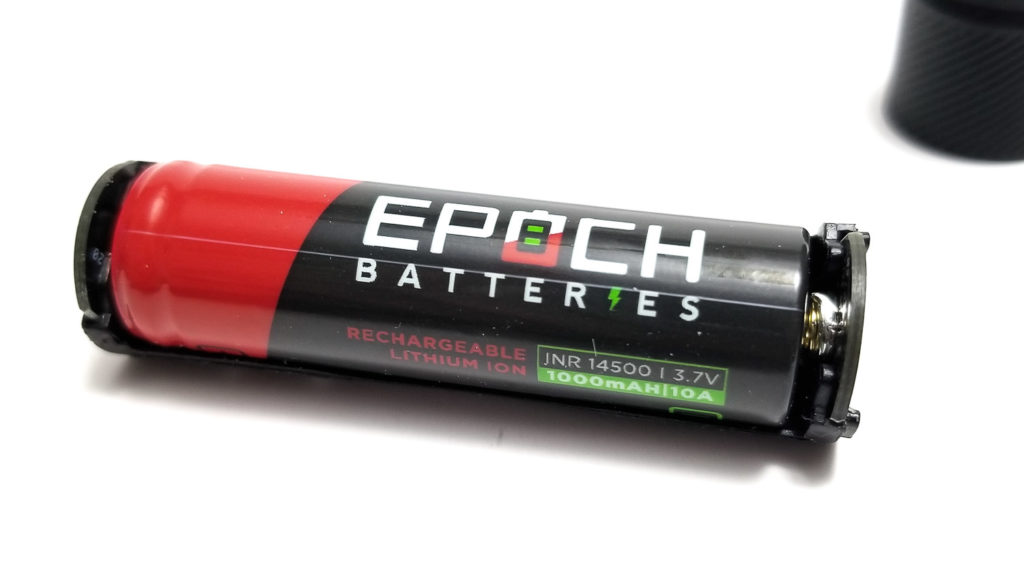
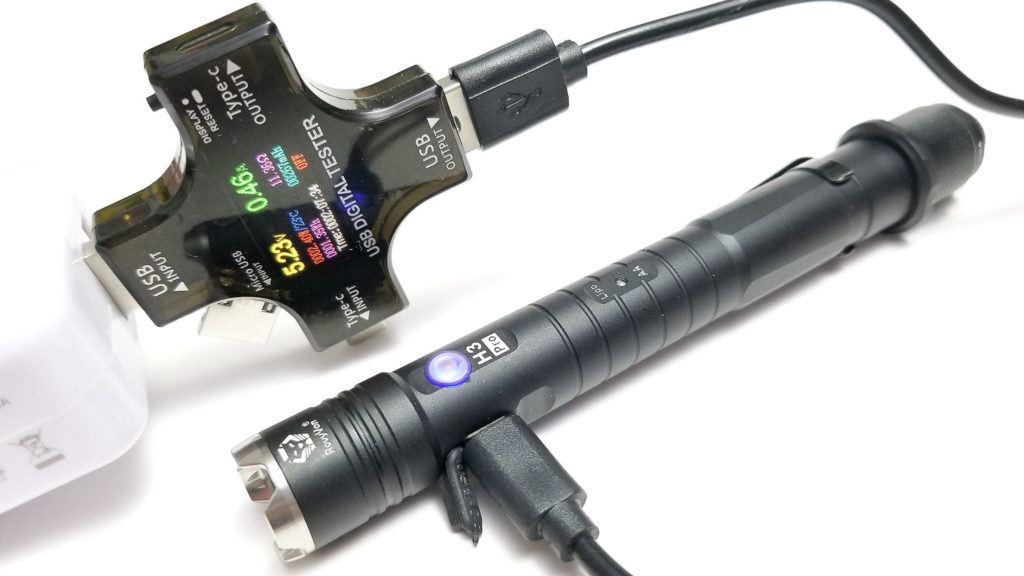
Performance
Lumen measurements (for each mode)
Lumens were measured using my home made 30 cm integrating sphere that’s been calibrated with several lights of known output including a Makkua-calibrated Convoy S2+. I use a Digi-Sense 20250-00 datalogging luxmeter. I used the built-in battery and an Ikea LADDA 2450 mAh Nimh. No amp measurement this time since the current path is not accessible. Specs for the Nimh are in parentheses.
| Mode | Amps at start | Specs | turn on | 30 sec | 10 min |
|---|---|---|---|---|---|
| Moonlight | N/A | 0.5 (Nimh same) | N/A | N/A | – |
| Low | N/A | 15 (10) | 17.43 (18.26) | 17.43 (18.26) | – |
| Med | N/A | 200 (60) | 173 (66) | 172 (66) | 100 (66) |
| High | N/A | 600 (120) | 490 (130) | 423(123) | 149 (105) |
I was down on the internal cell on High, but consistent with the Nimh specs. I tried a 10A Epoch 1000 mAh 14500 for comparison to see if the li-po battery was a bottleneck in any way, and it’s only on High that I saw a difference in output: At turn on the 14500 was clocking 564.40 Lumens on High, and was within 1 Lumen on Medium, so not enough of a difference to make a difference. Respectable output from what amounts to a fancy penlight.
Parasitic drain:
- N/A couldn’t measure
Runtime graph
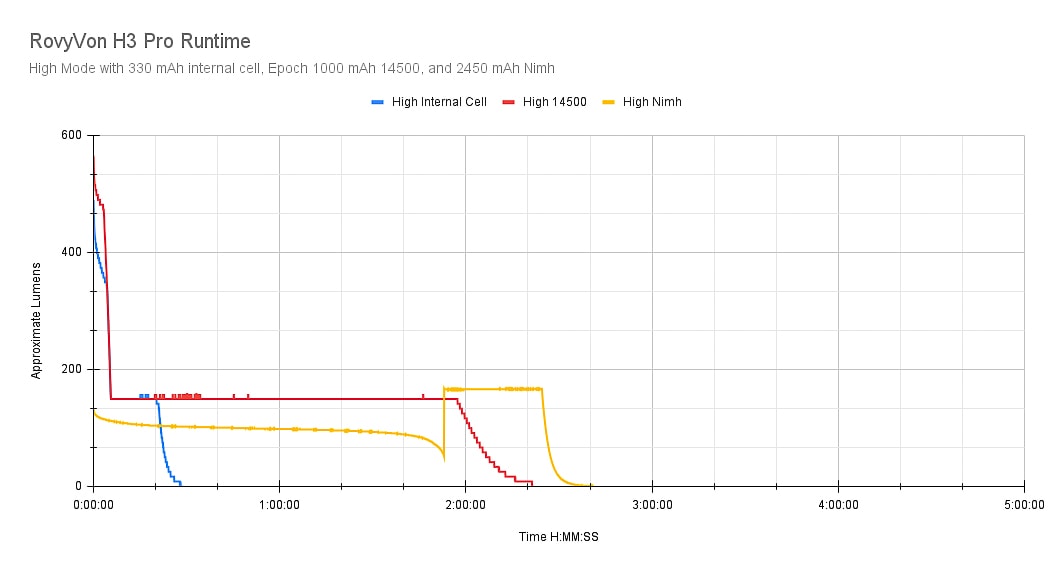
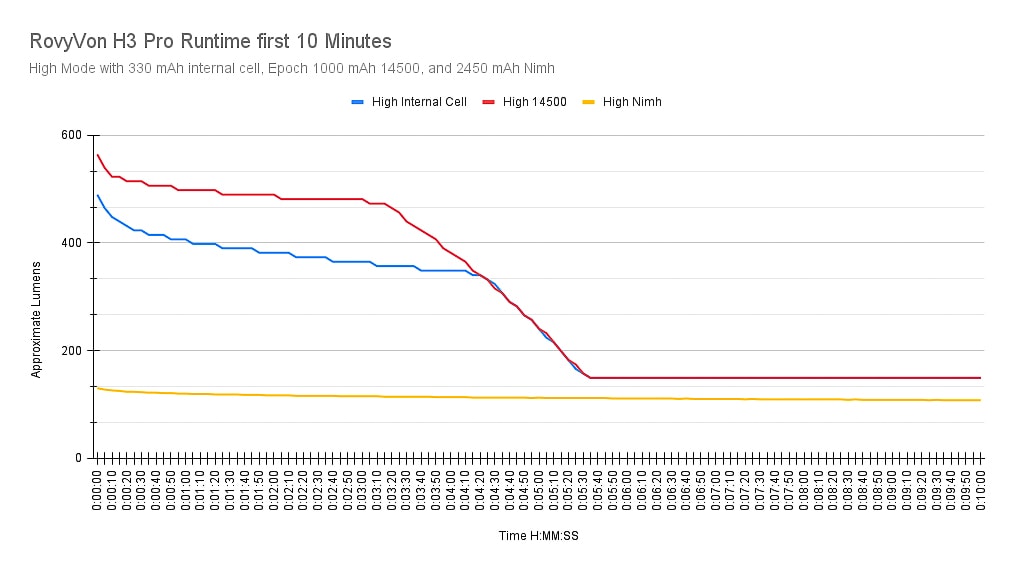
I ran the H3 Pro with the most common batteries available to the average user. I did not test an Alkaline cell due to variabilities in cell capacity, and brand. For the NImh I used the stalwart 2450 mAh Ikea LADDA (aka Laddaloop), and for the 14500 I used an Epoch 10 amp-rated 1000 mAh cell. I tested the High and Medium modes for each (fully charged) battery.
On the internal battery, High started a bit under 500 Lumens and no surprise, started dropping almost immediately, but not dramatically. By 10 seconds it’s down to 448.20, and by 60 seconds in, a hair over 400 Lumens. The output didn’t drop much over the next 4 minutes, but at the 5 minute mark, it really dropped, and by 5 minutes 30 seconds, it’s under 200 Lumens, settling at 149 Lumens. The output was solid from there, but 15 minutes later, LVP starts kicking in and drops the output very low. With the indicator blinking red under the switch, by 26 minutes in, the output is nearly zero, and the light shuts off completely at 28 minutes 35 seconds. RovyVon specs 35 minutes for the runtime. For the 14500, we’re seeing higher output for the first 4 minutes, but after the 4 minute 20 second mark, it’s all even-Steven, mirroring the internal battery. The difference? Longer runtimes afforded by the extra 560 mAh of the 14500. How much extra? Almost 2 hours. The 14500 was discharged a bit too deep, down to 2.42 volts. Heat wasn’t an issue at all, peaking at 47 C at 30 minutes in.
For the Nimh battery, I ran into a bit of an anomaly. The test started pretty normally at 130 Lumens, with slight drops over the next 10 minutes down to 107 Lumens, with a very slow drop off over the next hour and 20 minutes. By 1 hour 52 minutes, it’s down to 52 Lumens. I guess the H3 had a second wind (cue Chariots of Fire theme) because at 1 hour 53 minutes, the output jumps to 166 Lumens. This lasted for about 20 minutes, before a gradual ramp down, eventually shutting down at 2 hours 40 minutes. This jump more or less equaled the output of the internal cell on Medium, so perhaps the light decided it liked the internal battery better? To rule out instrumentation glitches, I ran the test twice, but I got the same result, so at least it’s consistent. For the runtime, RovyVon used a Panasonic Eneloop (of an undisclosed capacity) for their test with total runtime advertised at 1 hour. The Nimh was discharged to 1.13 volts after the test.
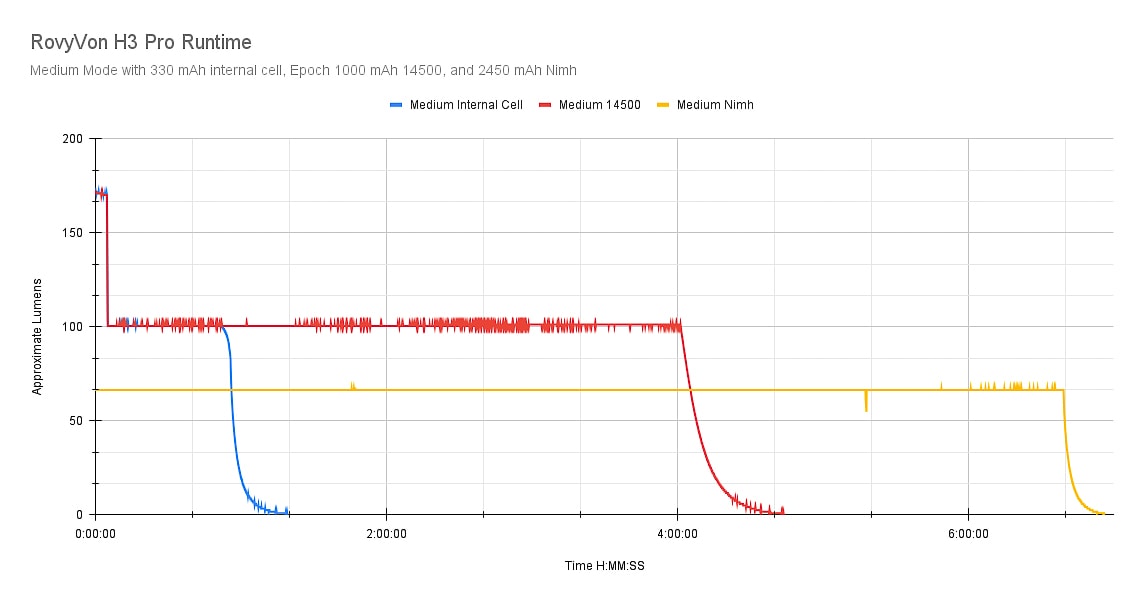
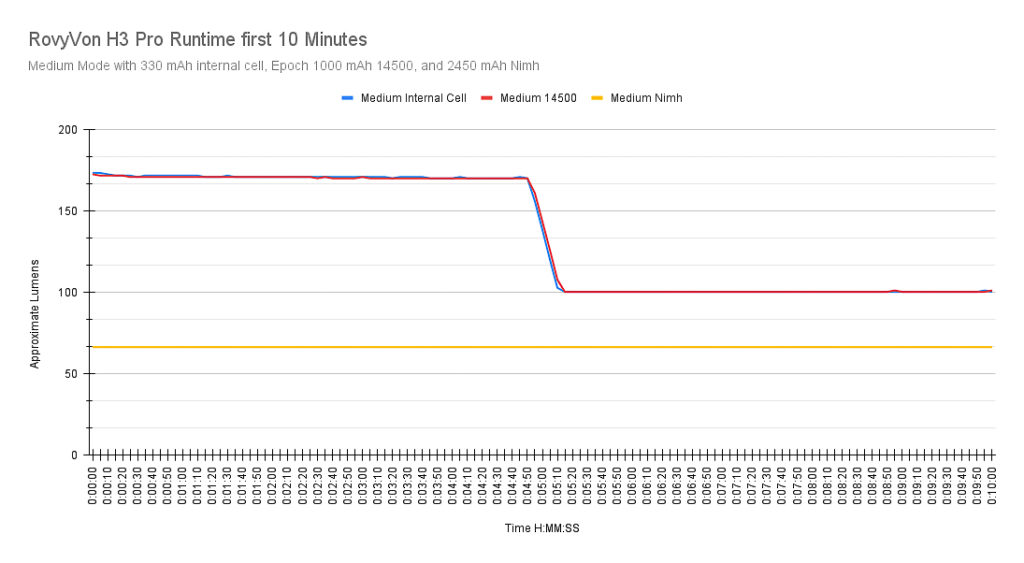
For Medium mode, like most low-power flashlights with high capacity cells, since I knew it would run for a while, I hunkered down and reflected on whether to have a cookies and cream-filled donut topped with Oreo cookie crumbles, or a chocolate covered custard-filled donut (yep, I had both).
The internal cell started at 173.74 Lumens (the 14500 was pretty much the same at 172) and was pretty consistent, only dropping a couple of Lumens until the 5 minute mark when the output dropped to 100 Lumens. It held that for another 47 minutes before stepping down slowly over the next 18 minutes until the 1 hour 14 minute mark when LVP drops the output, with the light shutting down 5 minutes later. Total time was 1 hour 19 minutes.
High was mostly a mirror-image, the difference being the longer runtime. When the internal cell quit, the 14500 kept soldering on for another 3 hours and 24 minutes, shutting down at 4 hours 43 minutes. Heat again wasn’t an issue, with the head barely reaching 30 C. The Nimh cell was the clear endurance winner here, starting at 66 Lumens and continuing with unwaveringly consistent output for the next 6 hours and 39 minutes until the output started dropping slowly. The ramp-down lasted for 16 minutes, with the light shutting down at 6 hours 56 minutes. End voltage was 1.14 volts. Heat wasn’t an issue, but it did get a bit warmer than the lithium cells at 36 C.
The tests went pretty normally aside from the weirdness with the Nimh High test. According to RovyVon, this is normal behavior (even though it only did it on the High test using an external cell). It does appear that once LVP pulls the Nimh back, the light switches (on its own) to the internal cell. It’s not clearly worded in the manual, but it only did it on this test. That aside, this is good performance from the H3 Pro, and typical of a current-regulated driver at work. The thermal regulation is flawless (if there is any), and the driver is nicely regulated as well. The li-ion battery was discharged too deep for my liking, and the Nimh was discharged pretty conservatively at 1.1 volts. Unless you switch the battery to the internal cell from the external cell, the light is deader than a brontosaurus.
Throw numbers:
I measured the throw with the Uni-T UT383S luxmeter indoors at 5 meters. I used the fully charged internal battery and a 2450 mAh Ikea LADDA Nimh. Figures for the Nimh are in parentheses.
| Mode | Specs | Candela measured | Meters | Yards |
|---|---|---|---|---|
| Moonlight | ? | N/A | N/A | N/A |
| Low | ? | 150 cd (175 cd | 24 (26) | 27 (29) |
| Medium | ? | 2025 cd (750 cd) | 90 (55) | 98 (60) |
| High | 3500 cd (1200 cd) | 4925 cd (1425 cd) | 140 (75) | 153 (83) |
RovyVon only lists the maximum cd and throw figures for the li-po battery and Nimh (the manual specifies a Panasonic Eneloop was used for the Nimh figure). RovyVon’s specs for the internal cell is 120 meters and 70 meters for the Nimh, so I’m getting better than that, and these are pretty decent figures for a tiny reflector. (no doubt helped along by the domeless emitter). In fact, these numbers rival larger lights with domed LEDs.
Beamshots
I compared the H3 Pro with some lights of similar size and configuration. I dusted off some old lights I don’t use much, and to keep it consistent, I ran the AA/li-ion capable lights on 14500s:
The ancient 1xAAA Thorfire PF01 with Cree XP-E2 (about 90 Lumens on an Ikea LADDA 900 mAh Nimh), equally ancient Solarstorm SC01 (Cree XM-L2 5500K, about 500 Lumens), Fenix E09R (Luminus SST20, 650 max Lumens on built-in li-po battery), 2xAA Thrunite Archer V2 3A (Cree XP-L2 550 Lumens), Brinyte HL16 (Cree XP-G3, around 600 Lumens), and a Sofirn SP10 V3 (Samsung LH351D around 1000 Lumens on 14500).
Indoor pictures: The end of the hallway is about 12 meters distant. No surprise, the Thorfire lags way behind, and the Sofirn SP10v3 belting out around 900+ Lumens from the 14500 blows them away. The Thrunite, Solarstorm, Brinyte, Fenix and RovyVon are pretty evenly matched.
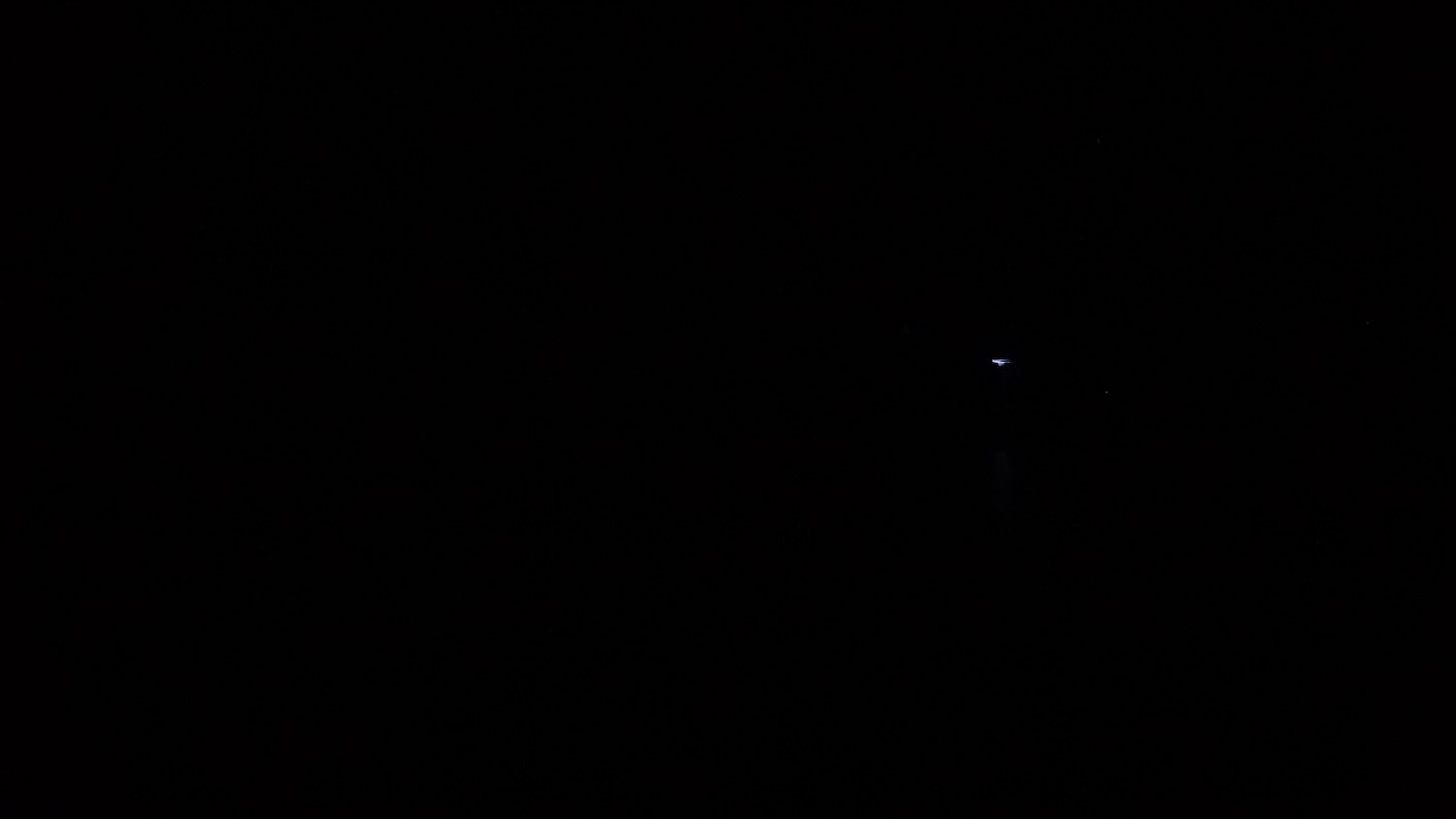
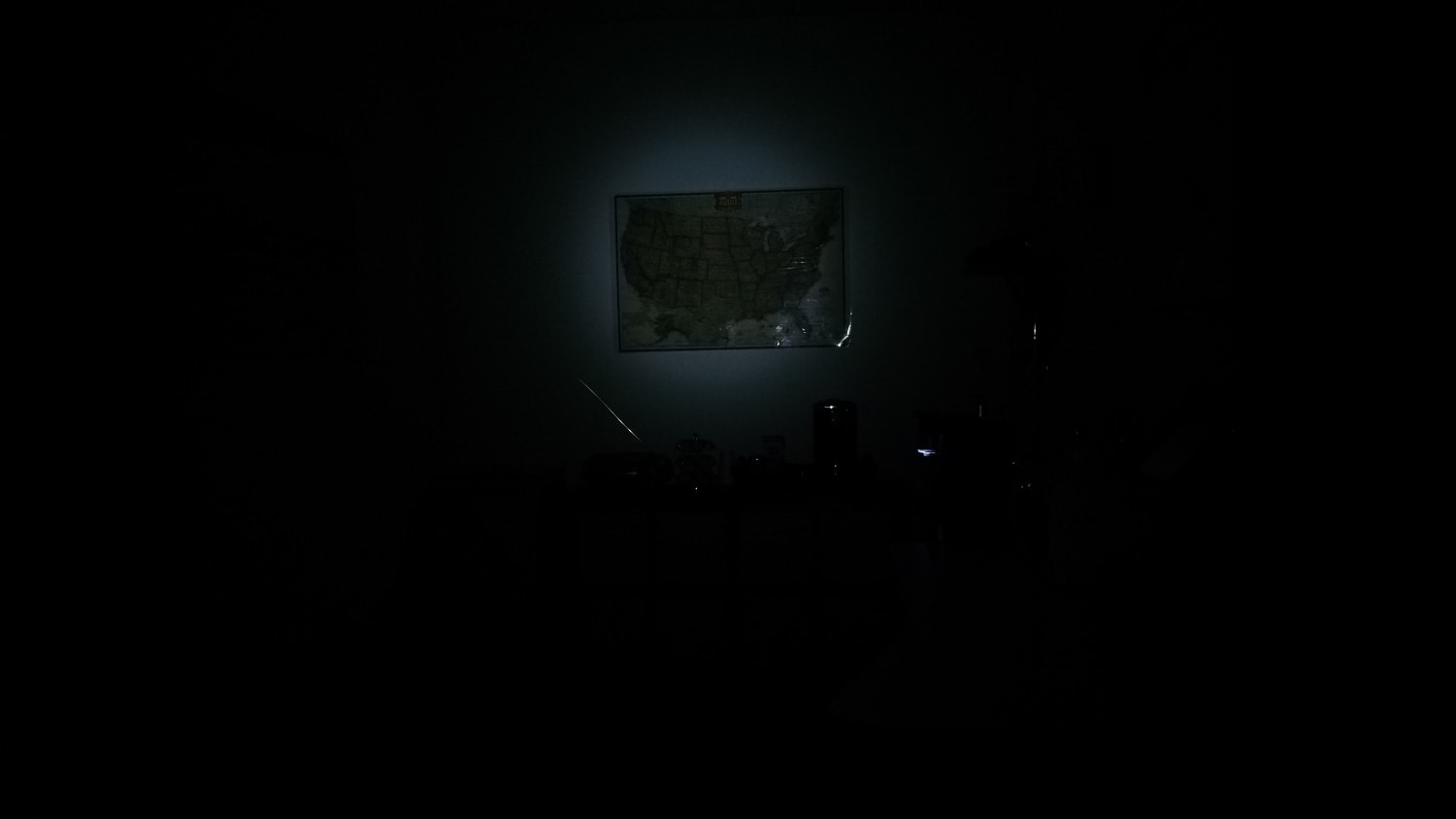

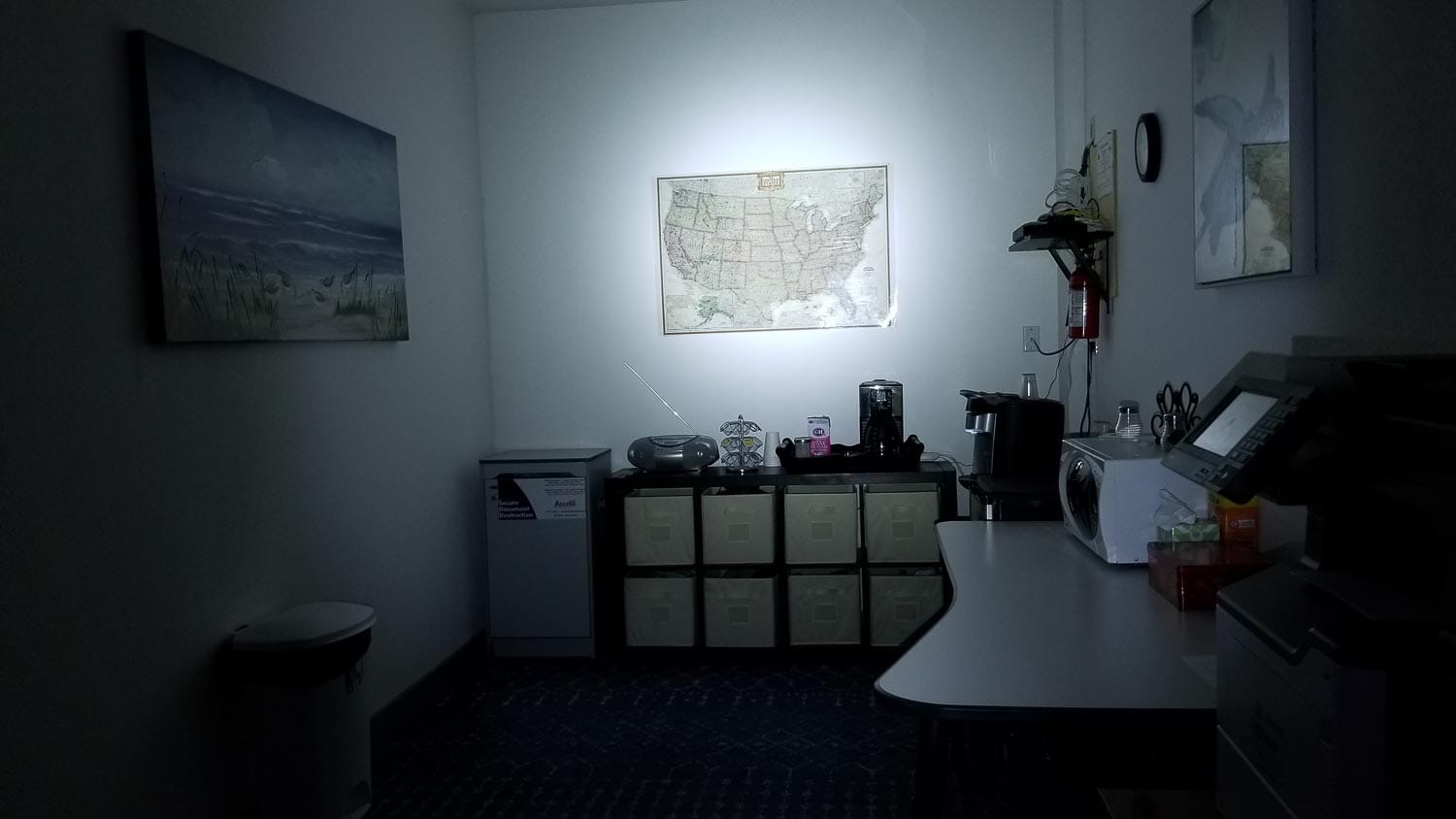
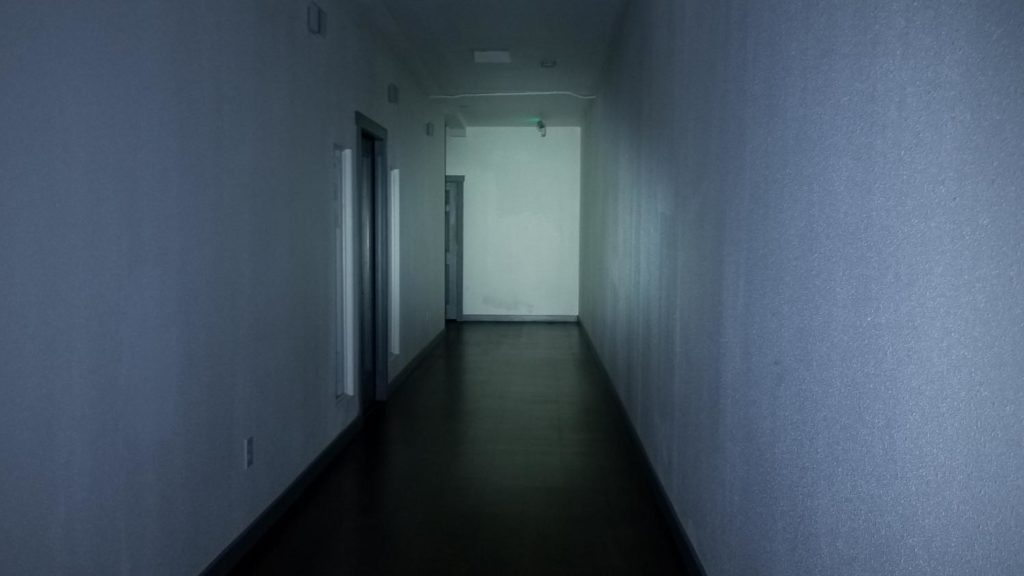
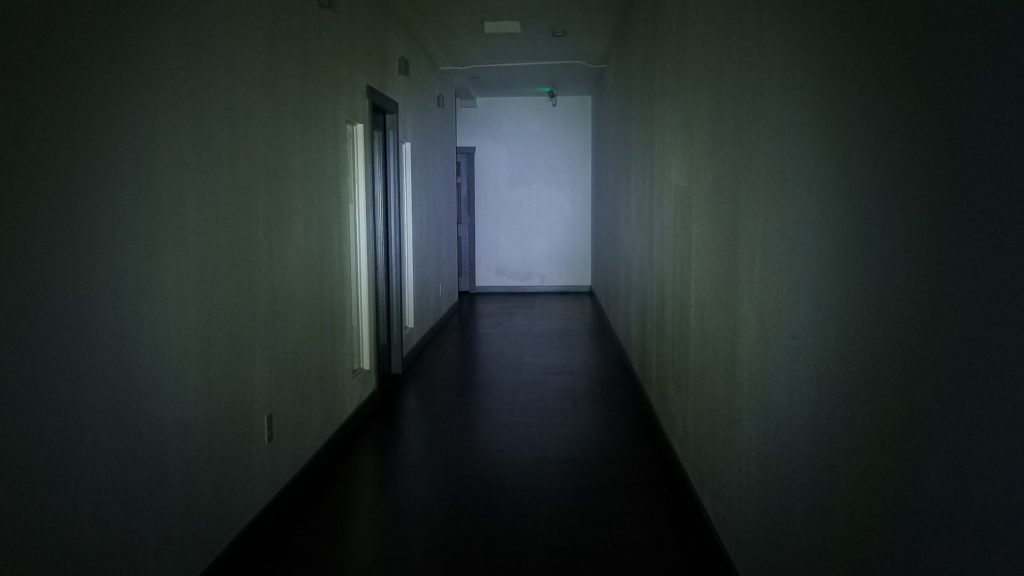
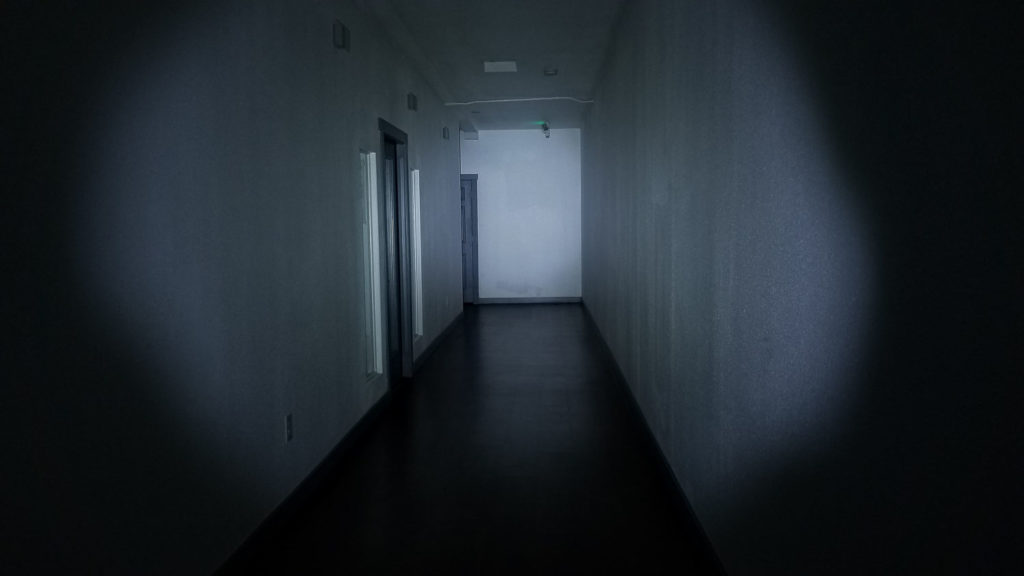
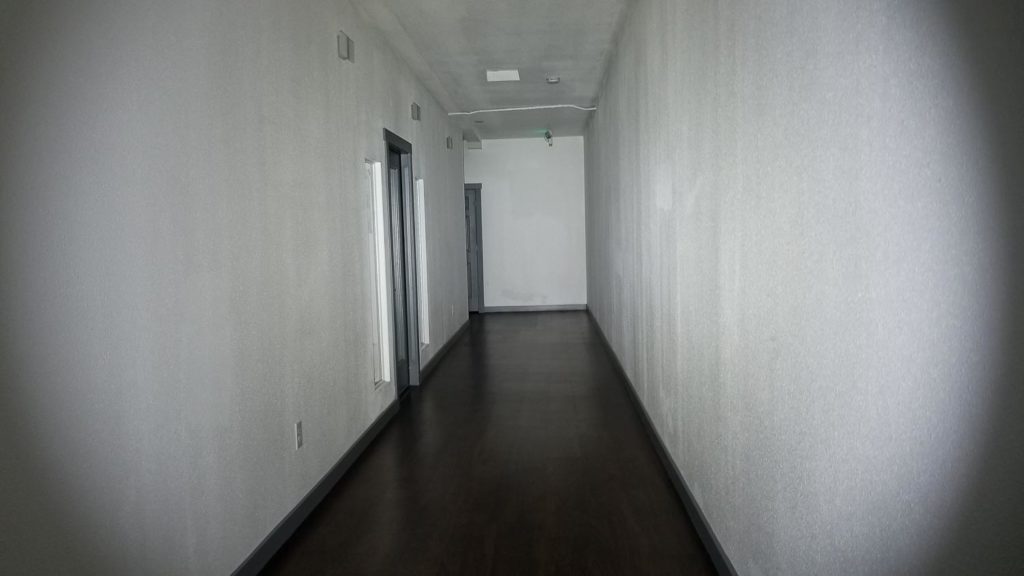
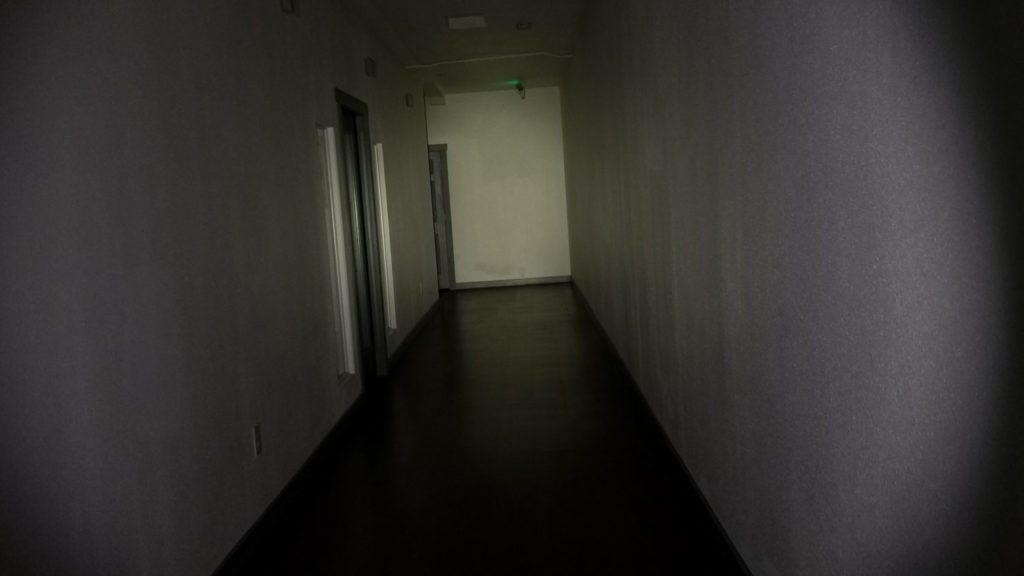
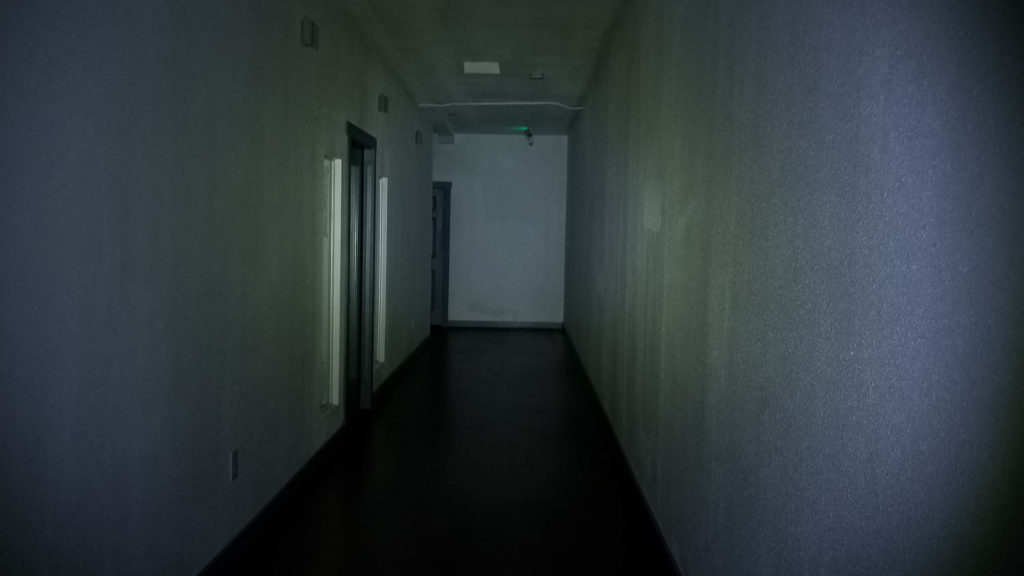
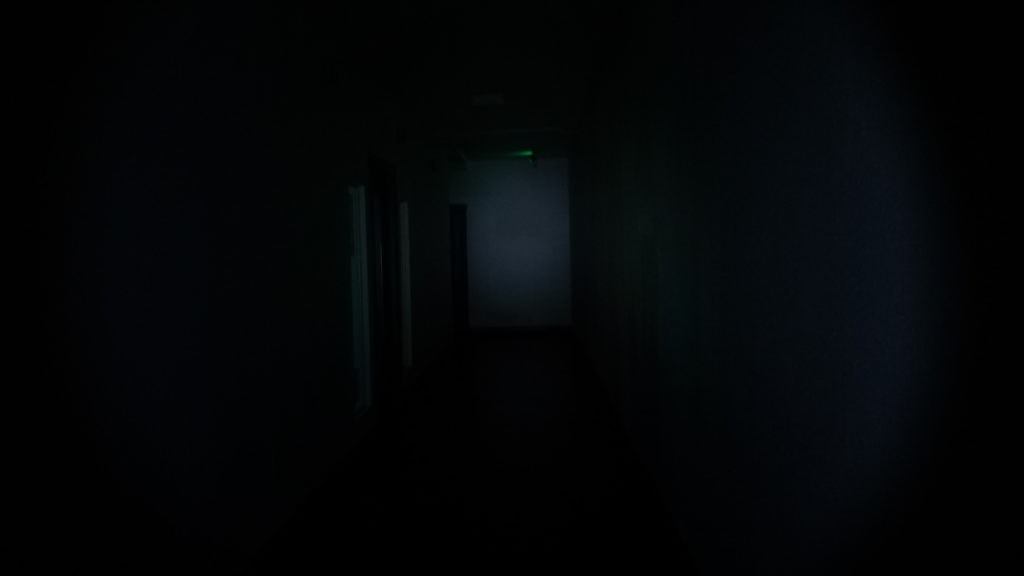
Disclaimer: This flashlight was sent to me for review at no cost by RovyVon. I have not been paid to review, nor have I been holding back on problems or defects.
Final Verdict
Pros
- Hybrid battery works fine
- Nice anodizing and solid built quality
- Very consistent output
- Decent throw and nice beam
- Intuitive UI with well-implemented dual switches
Cons
- A bit pricey
- Removable cell carrier seems flimsy
- Some button top AAs didn’t really fit
- Too-tiny side switch
- 14500 battery was discharged a little deep
Explanation on star ratings:
1: Avoid: my phone flashlight would be a better choice – 2: Poor: significant defect or issues; almost unusable – 3: Average: some defects or issues; but still usable 4: Good: recommended (minor issues) – 5: Great: highly recommended

4 stars: ★★★★
As a brand, I really like how RovyVon is forward-thinking, innovative, and bold enough to bring unique, niche products to market. Who else has a dual-TIR keychain light called Angel Eyes (Lee Van Clef)? This has been the case with a lot of RovyVon lights over the years, cranking out functional, high-quality, and downright exotic flashlights for EDC, professional use, or just sitting on your shelf and looking pretty.
The RovyVon H3 Pro? Overall this is a great idea that I think deals with a pain point with flashlights, namely what to do when the battery dies and you don’t have a charger or spare battery handy? The fact that the H3 Pro is rechargeable is a welcome feature as well, and I like the solid built quality, great finish, and the output is very consistent. It’s slim and lightweight to boot, and would be equally at home on a duty belt as a backup light or in your pocket.
However, it wouldn’t be a RovyVon without some quirks, so here goes: I do not like the wonky Hobbit/fairy finger-sized e-switch, and the cell carrier seemed like it would break if I was too rough with it. I didn’t like how deeply it discharged my 14500s, and it’s kind of pricey for what it is as well. The hybrid battery functionality is a great feature, and I think there’s room for improvement here for sure. With some revisions, this would be a fantastic multipurpose light. 4 stars for the H3 Pro.
RovyVon H3PRO For Sale
1lumen selects and reviews products personally. We may earn affiliate commissions through our links, which help support our testing.